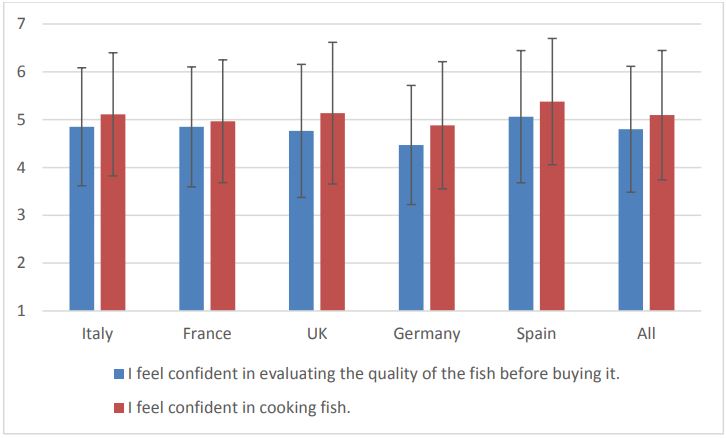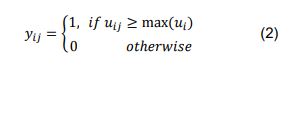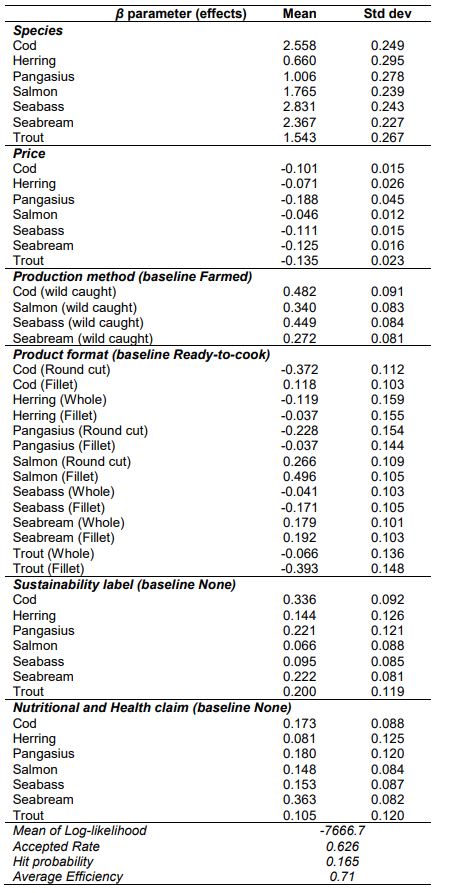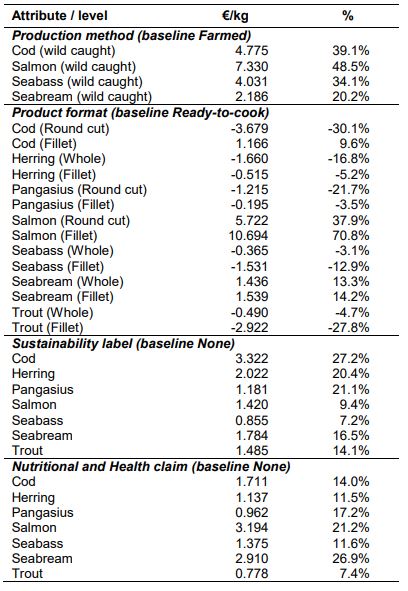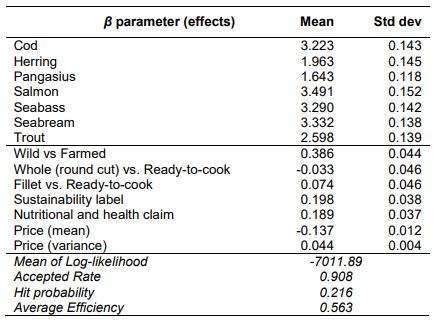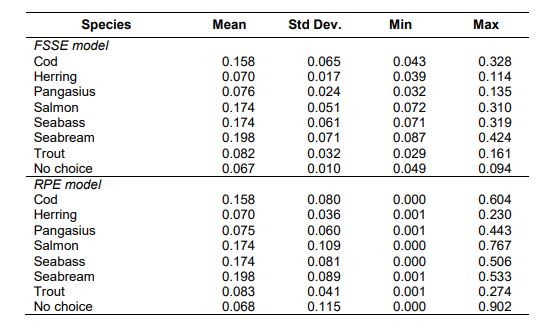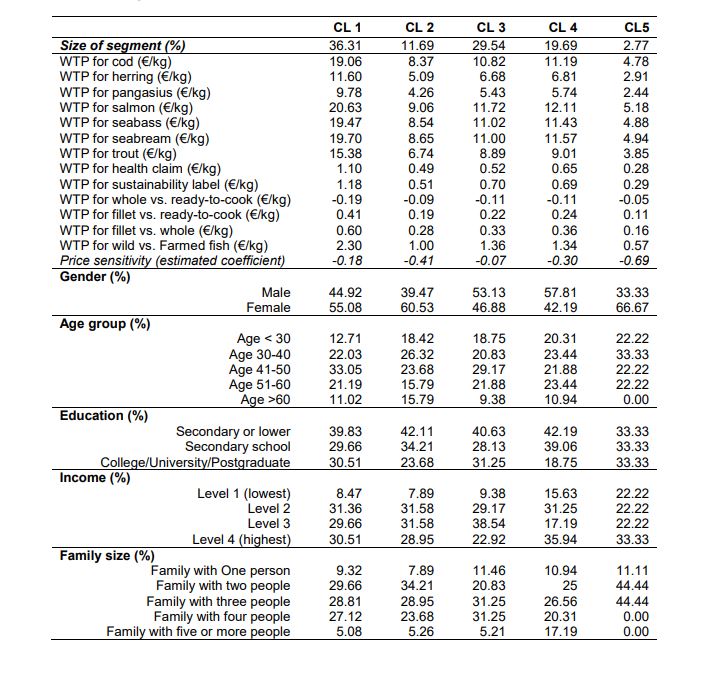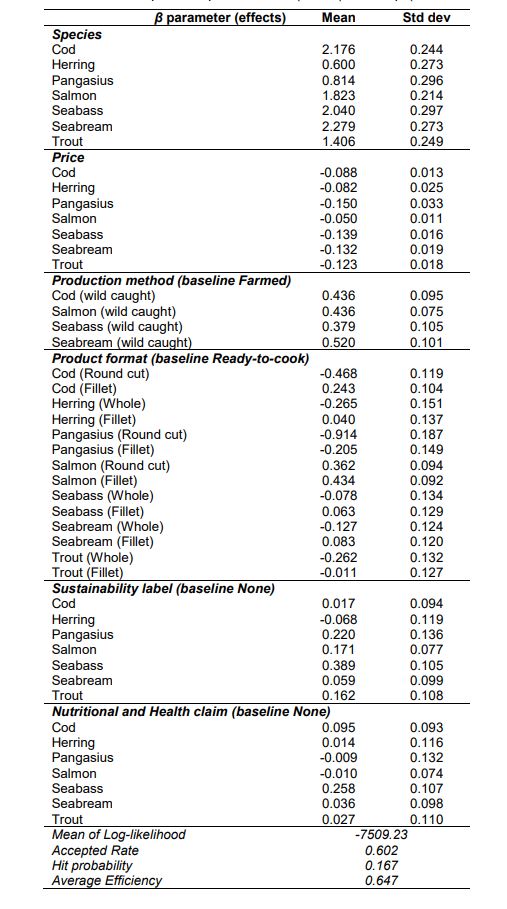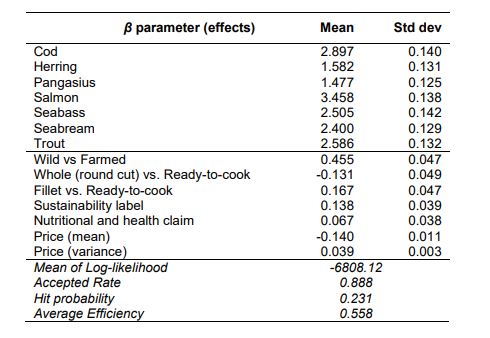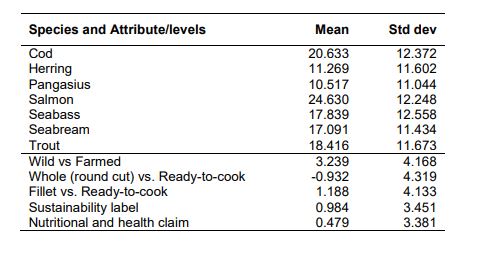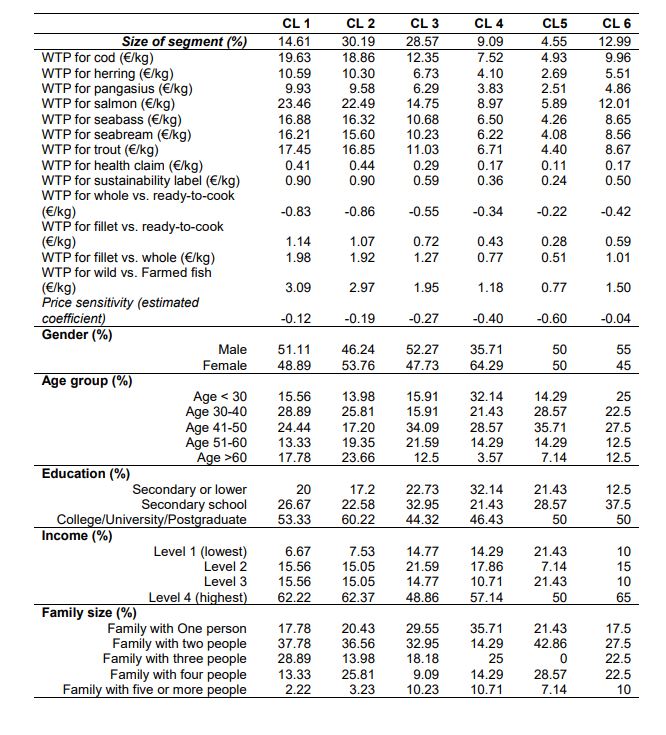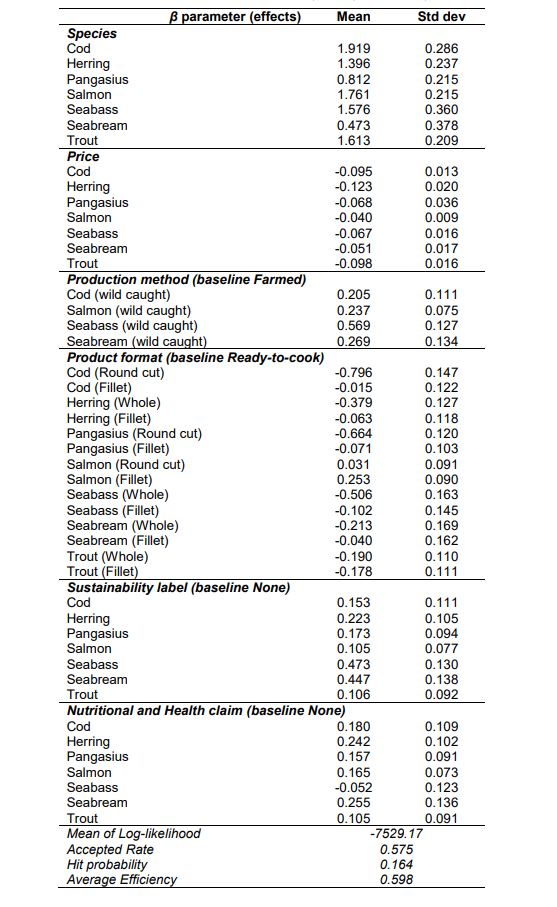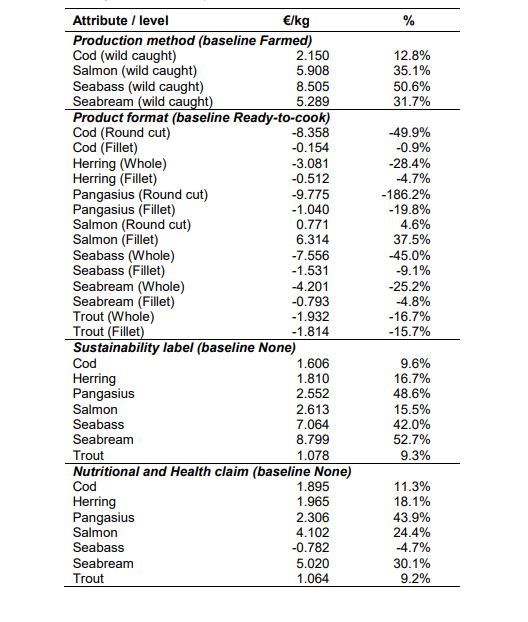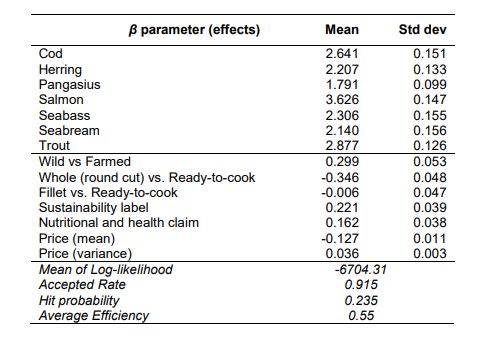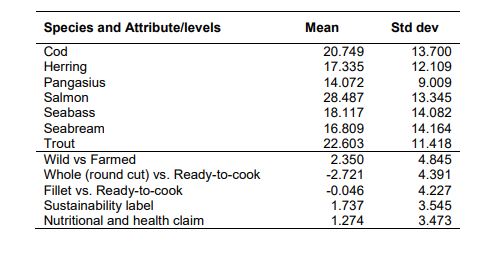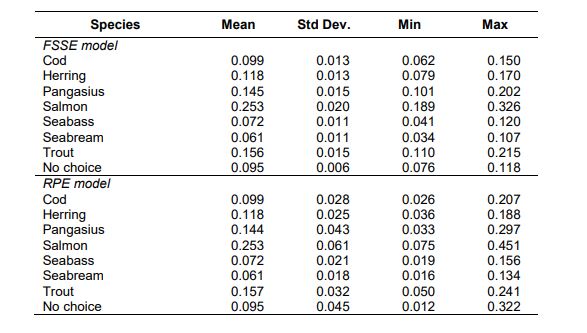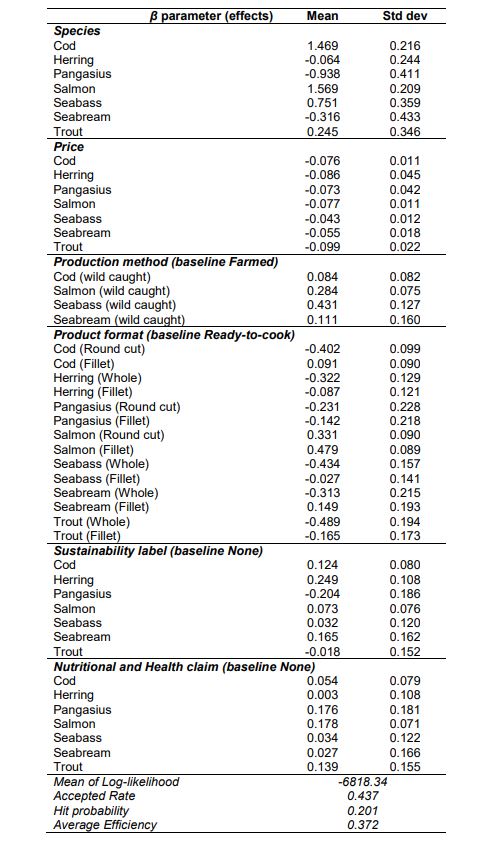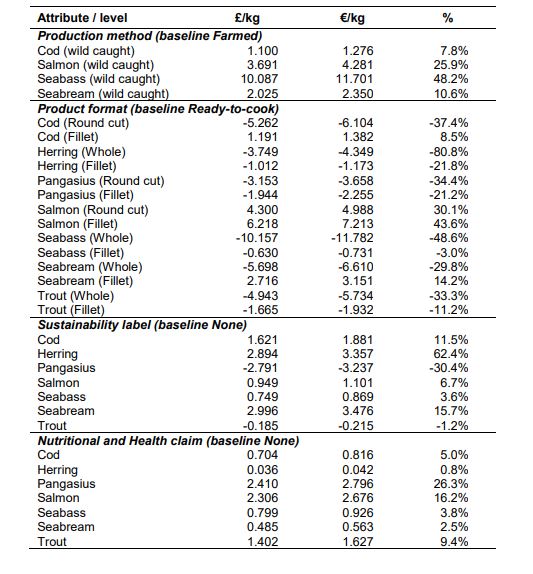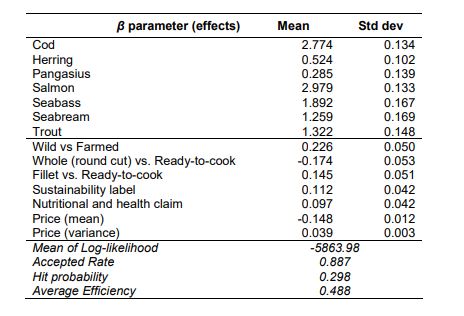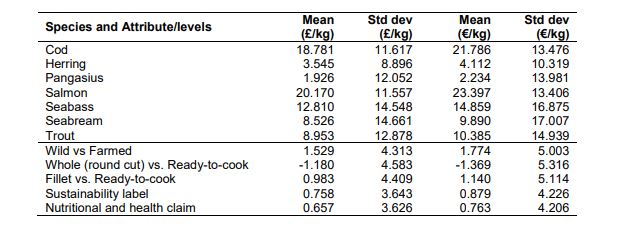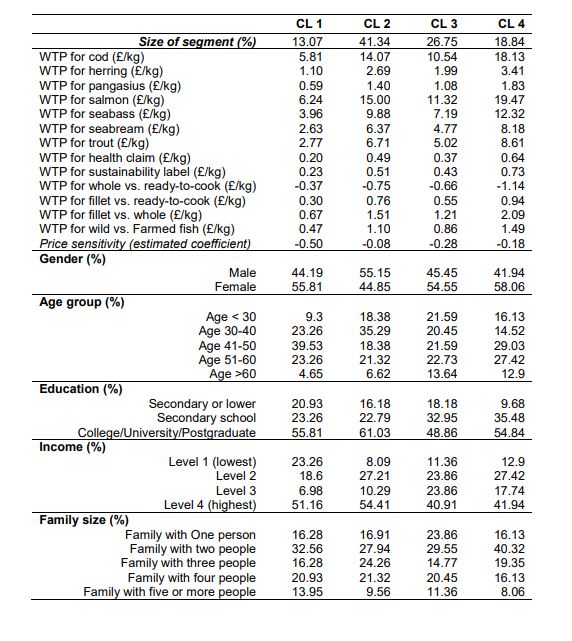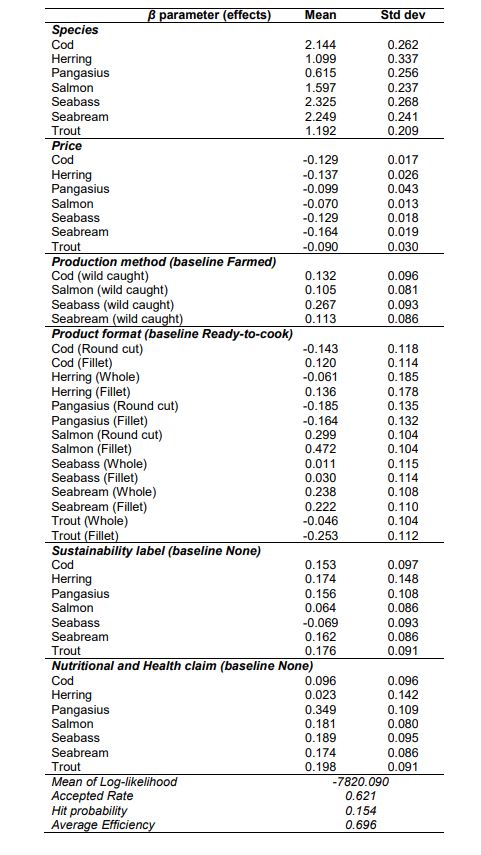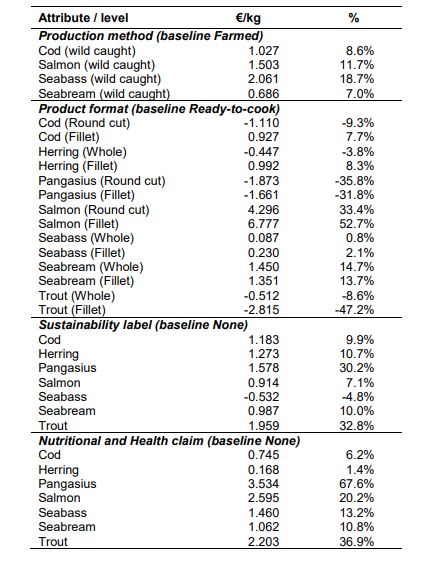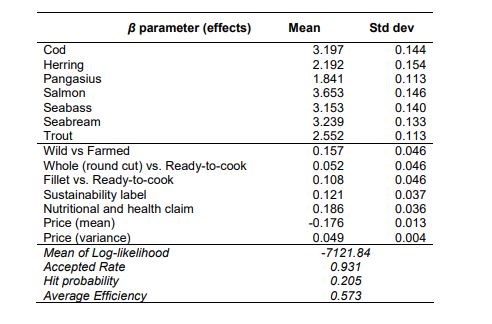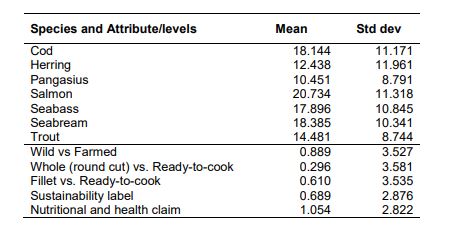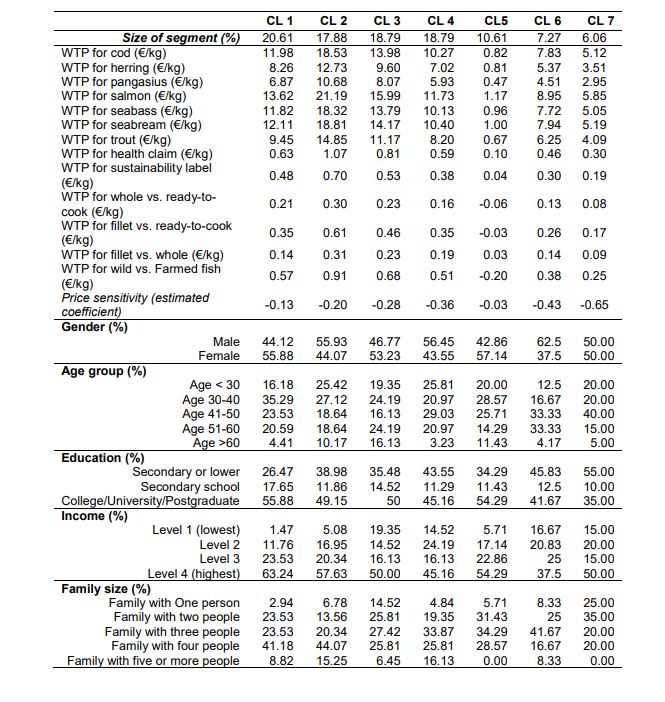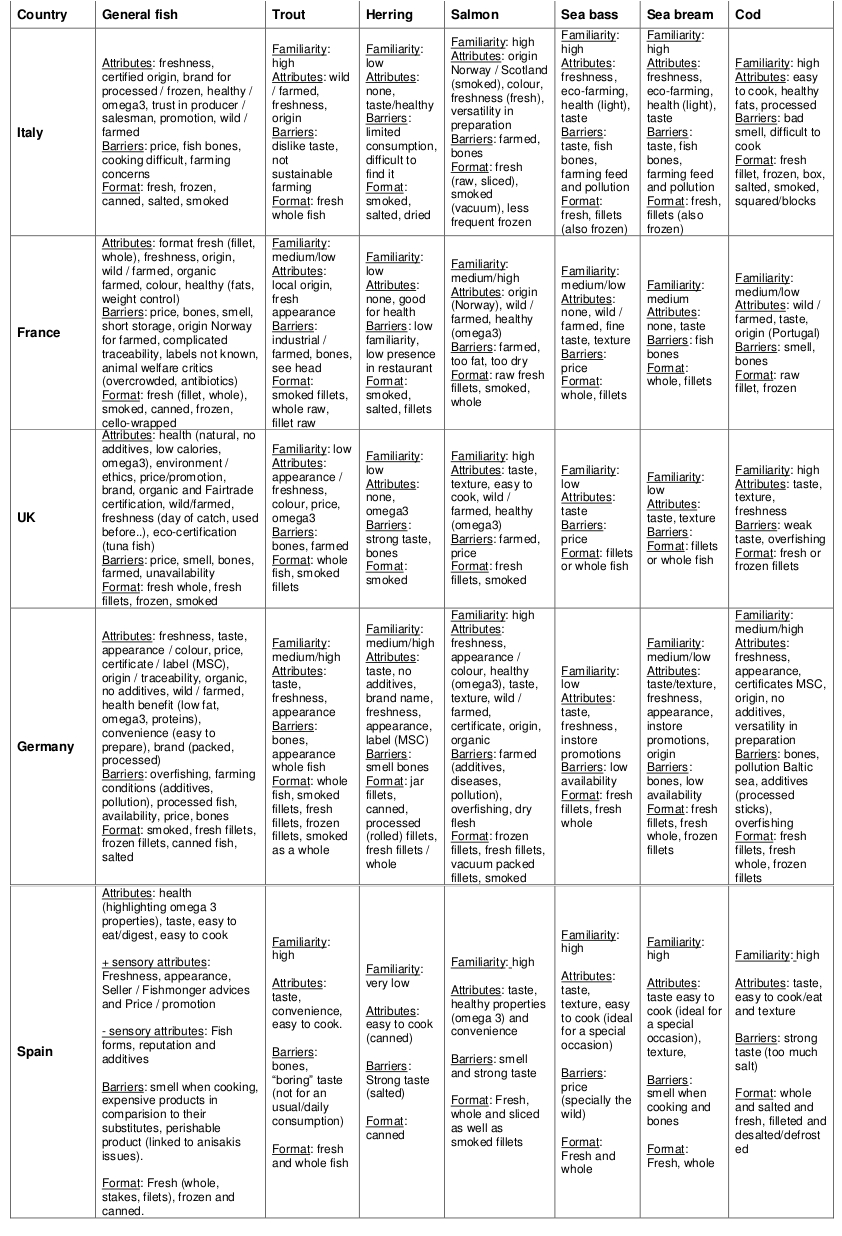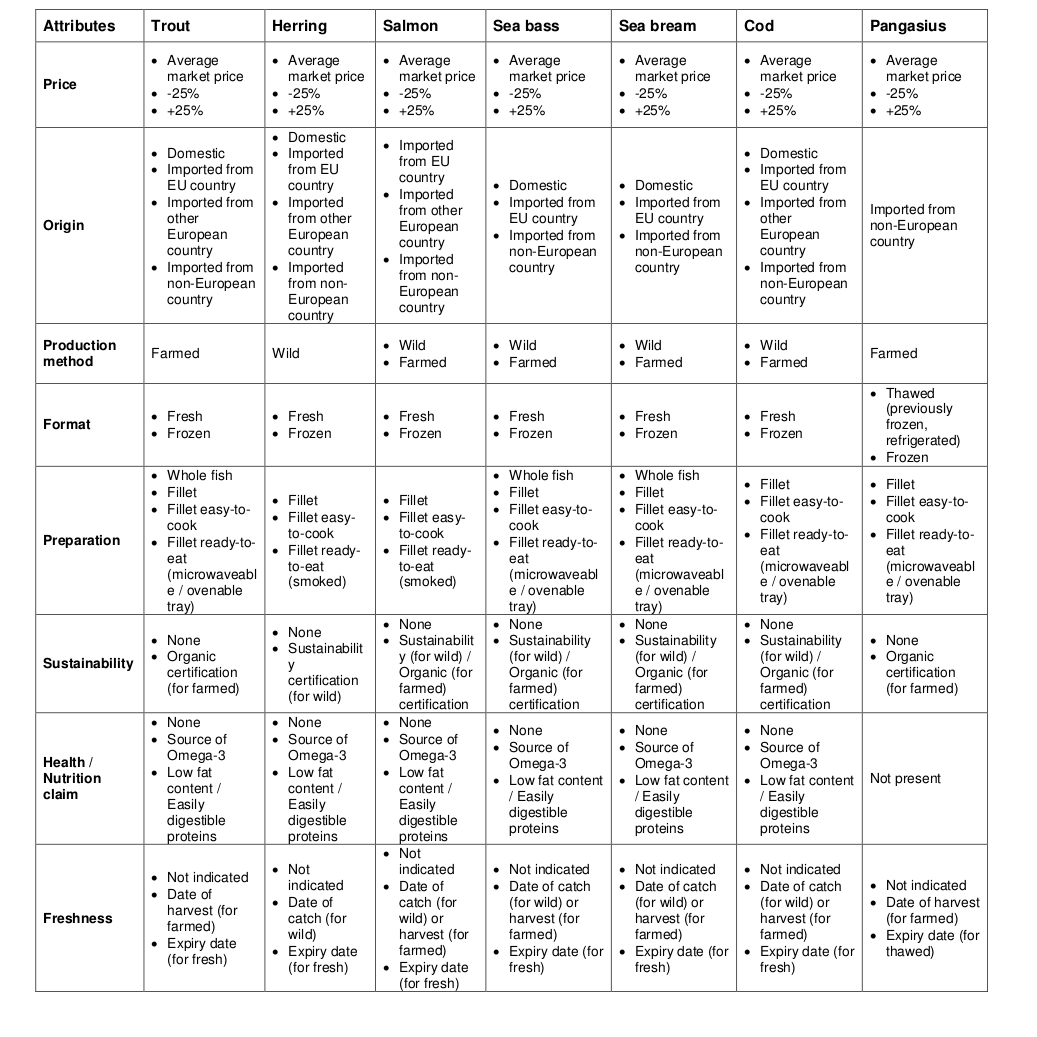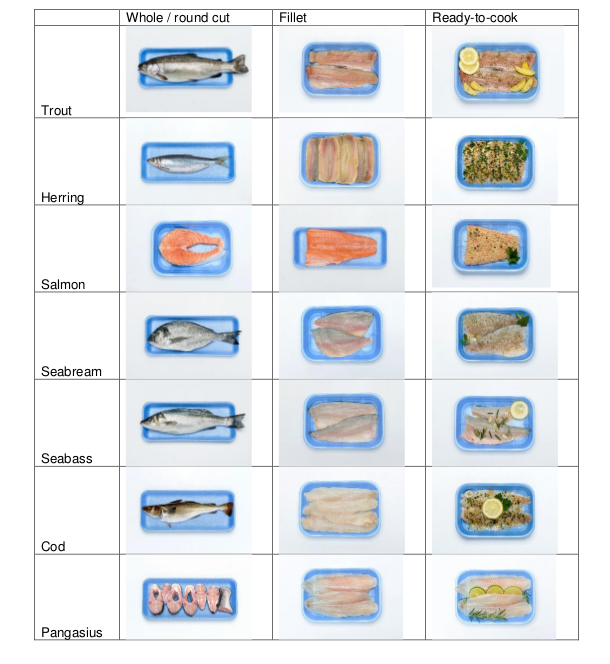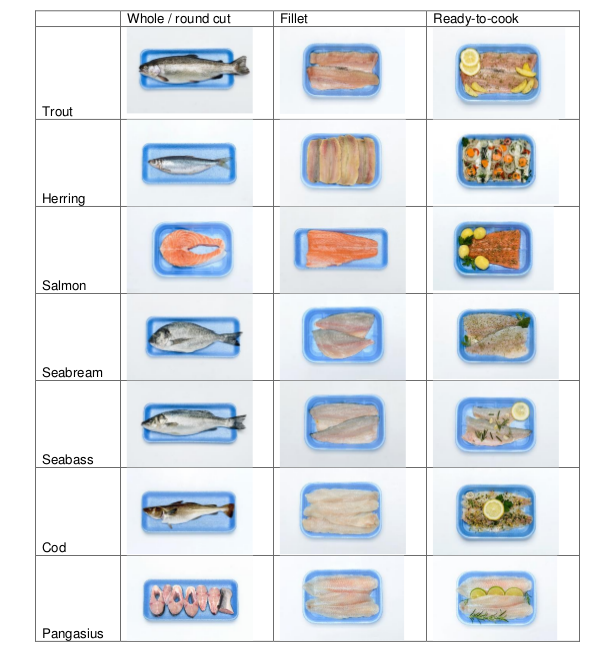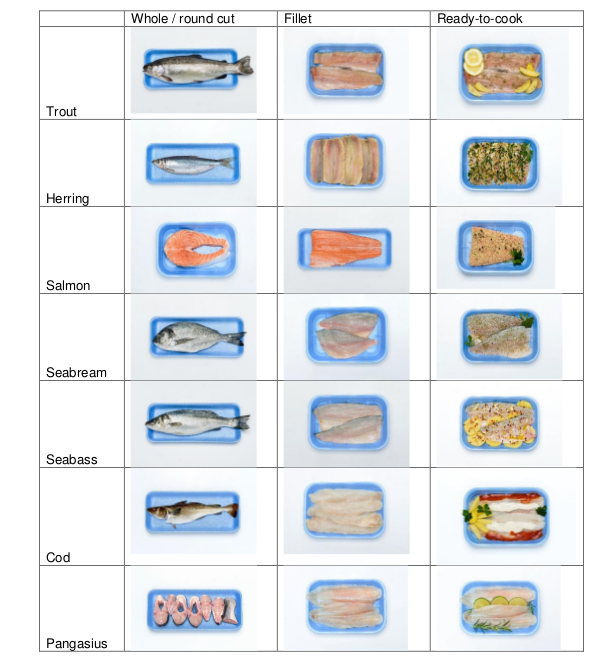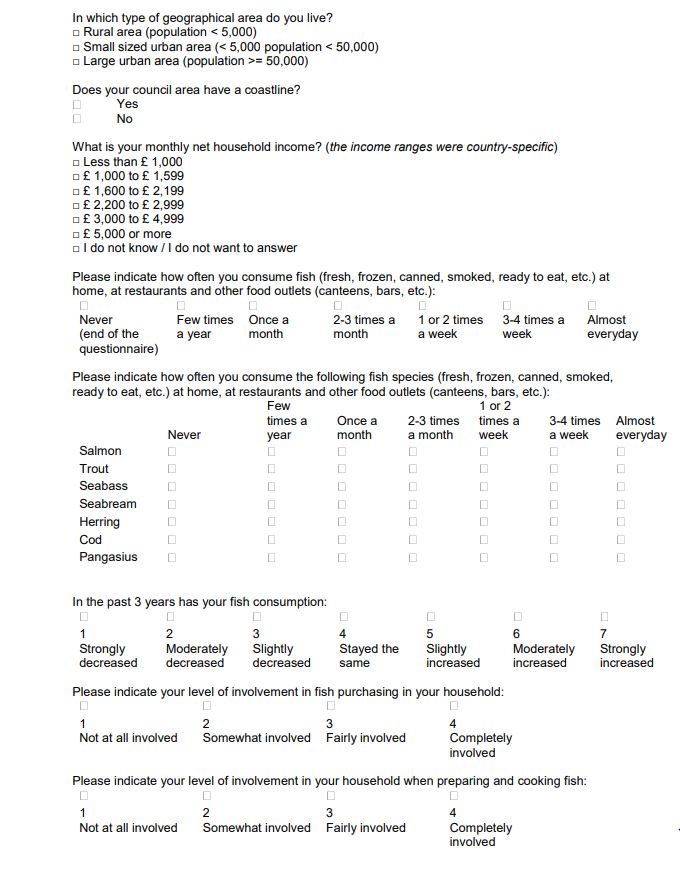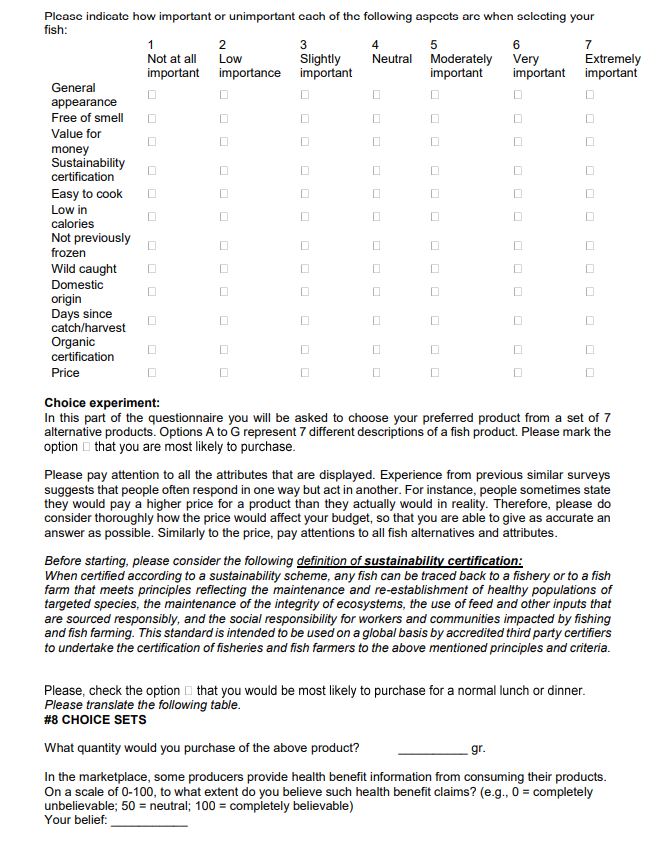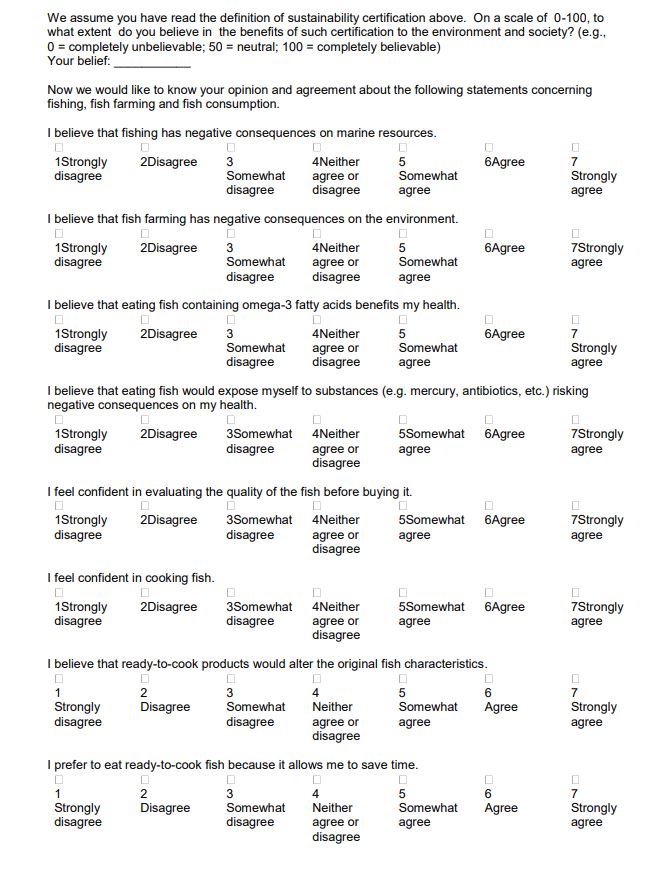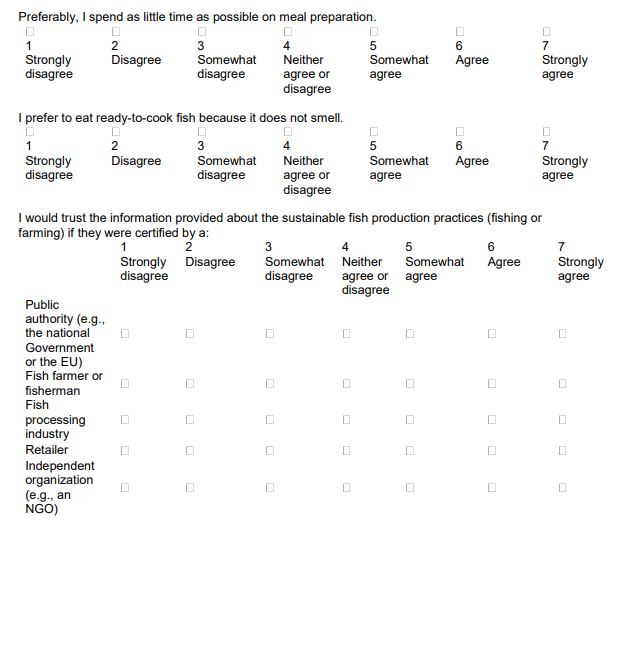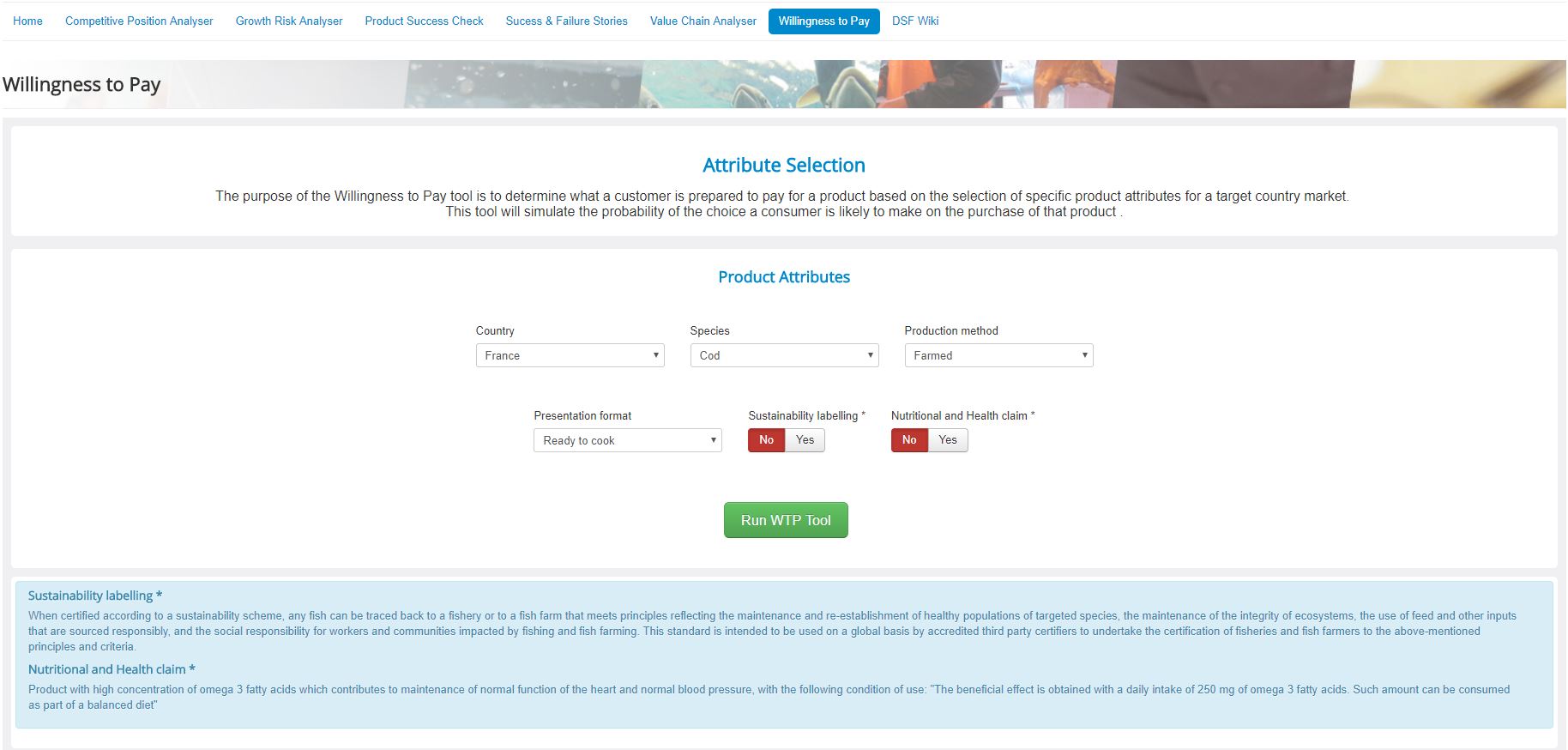Difference between revisions of "WTP"
Jacandrade (talk | contribs) |
Jacandrade (talk | contribs) |
||
| Line 1: | Line 1: | ||
| + | |||
= Willingness to Pay = | = Willingness to Pay = | ||
| Line 1,881: | Line 1,882: | ||
''Table A1: Familiarity, attributes, barriers, and format for fish species and countries, as retrieved from the qualitative phase (Task 4.1)'' | ''Table A1: Familiarity, attributes, barriers, and format for fish species and countries, as retrieved from the qualitative phase (Task 4.1)'' | ||
| + | |||
[[File:Wtp_table_a1.JPG|center|WTP Table A1.]] | [[File:Wtp_table_a1.JPG|center|WTP Table A1.]] | ||
| Line 1,886: | Line 1,888: | ||
''Table A2: Preliminary list of attributes and levels by species.'' | ''Table A2: Preliminary list of attributes and levels by species.'' | ||
| + | |||
[[File:Wtp_table_a2.JPG|center|WTP Table A2.]] | [[File:Wtp_table_a2.JPG|center|WTP Table A2.]] | ||
| Line 1,892: | Line 1,895: | ||
=====France===== | =====France===== | ||
| − | [[File:Wtp_table_a3_france. | + | [[File:Wtp_table_a3_france.png|center|WTP Table A3 - France.]] |
=====Germany===== | =====Germany===== | ||
| − | [[File:Wtp_table_a3_germany. | + | [[File:Wtp_table_a3_germany.png|center|WTP Table A3 - Germany.]] |
=====Italy===== | =====Italy===== | ||
| − | [[File:Wtp_table_a3_italy. | + | [[File:Wtp_table_a3_italy.png|center|WTP Table A3 - Italy.]] |
=====Spain===== | =====Spain===== | ||
| − | [[File:Wtp_table_a3_spain. | + | [[File:Wtp_table_a3_spain.png|center|WTP Table A3 - Spain.]] |
=====UK===== | =====UK===== | ||
| − | [[File:Wtp_table_a3_uk. | + | [[File:Wtp_table_a3_uk.png|center|WTP Table A3 - UK.]] |
Revision as of 01:17, 9 February 2018
Contents
Willingness to Pay
Introduction
The average apparent fish consumption per capita in the EU is the second highest in the world (at around 22 kg/capita/year), and some individual EU Member States are among the highest fish consuming countries in the world (EEA, 2016). The EU is the largest market in the world for fish; with a value of €55 billion and a volume of 12 million tons (FAO, 2016). While EU fish and seafood consumption has risen over the past 10 years with stable or declining supply from the fisheries sector, most of this increase has come from imports rather than from EU aquaculture. In 2014, around 75% of fisheries and aquaculture products consumed in the EU came from marine capture fisheries, which remains consistent with trends over the last decade (EUMOFA, 2015). Today 25% of all EU seafood consumption comes from EU fisheries, 10% from EU aquaculture and 65% from imports from third countries, both fisheries and aquaculture products. European aquaculture growth has stagnated since the turn of the century partly because its products have not been competitive compared with imports. In a market driven by the demand a better understanding of consumer purchasing behaviour towards fish products is paramount to developing more effective marketing and policy strategies (Carlucci et al., 2015). Therefore, understanding the consumers’ preferences across the EU countries for fish species and fish product attributes is crucial to sustain the fisheries and aquaculture sectors. The objective of this study was to investigate consumer demand and choice behaviour for fresh fish at the retail market. In particular, we examined consumer preferences for different fish alternative species, as well as different attributes. The outcomes allowed us to elicit consumers’ preferences and willingness to pay (WTP) for the salient attributes of a variety of fresh fish species in the retail market. We applied a discrete choice experiment (DCE) to accomplish this objective; this method is strongly consistent with the economic demand theory and in particular with the multi-attribute demand studies based on the Lancastrian consumer theory (Lancaster, 1966), This theory assumes that consumer’s utility stems from product properties rather than the products themselves. Thus, multi-attribute demand models can elicit the intrinsic value of the product attributes and have been applied widely in marketing research. Moreover, this method is highly flexible with respect to data collection and model specifications. DCE is based on random utility theory about individual decision making, and seems realistic in imitating real shopping behaviour (Louviere et al., 2000). Choice modelling techniques are multi-attribute valuation techniques that elicit values for multiple attributes by asking respondents to rate, rank or choose a set of attributes (levels). In particular, choice experiments are valuation techniques where respondents have to make trade-offs and indicate their preferred option out of a set of alternatives. We developed a choice-based on-line experiment, on a number of 500 respondents per country (Italy, France, Spain, UK and Germany). The profile attributes and levels analysed are derived from previous qualitative tasks (i.e., qualitative analysis by in-person interviews), and include product innovation features such as health claims, sustainability certification, etc. To accommodate the evaluation of choice alternatives through both attribute judgment and alternative comparison, we applied a labelled choice experiment (LCE), where choice alternatives were labelled by the respective names of the seafood (e.g., salmon, cod, herring, etc.) (Nguyen et al., 2015). We set our model specification in such a way that the constant terms, which represent intrinsic value of the alternatives, and attribute parameters were varied both over fish alternatives and across countries. The WTP associated with each attribute, by species and country, was also estimated.
Methods
We applied a labelled choice experiment (LCE) to investigate consumer demand and choice behaviour for fresh fish in a retail market hypothetical situation in five European countries: Italy, France, Spain, UK and Germany. The LCE was conducted for seven fish alternatives (i.e., cod, herring, seabass, seabream, salmon, trout and pangasius) labelled by the respective fish names. Consumer heterogeneity in preference was expressed by estimating a labelled latent class model with alternative-specific effects, which varies choice probability and model parameters over seafood alternatives and across classes. The WTP for extrinsic attributes (i.e., product format, production method, health claim, and sustainability certification), and the rank orderedintrinsic value are estimated for each seafood alternative within classes and the entire market. The WTP estimate in our study is expected to be more accurate than those derived from studies based on single product alternatives because the LCE allows respondents to evaluate choice alternatives through both attribute judgment and alternative comparison. Exploring a variety of product alternatives is also meaningful to firms with multiple products (e.g., fresh fish retailers) or firms with many direct competitors.
2.1 The choice experiment
The choice experiment was preceded by a cheap talk aiming at explaining the rationale behind the experiment and the need to respond carefully to the questions: “In this part of the questionnaire you will be asked to choose your preferred product from a set of 7 alternative products. Options A to G represent 7 different descriptions of a fish product. Please mark the displayed. Experience from previous similar surveys suggests that people often respond in one way but act in another. For instance, people sometimes state they would pay a higher price for a product than they actually would in reality. Therefore, please do consider thoroughly how the price would affect your budget, so that you are able to give as accurate an answer as possible. Similarly to the price, pay attentions to all fish alternatives and attributes“. At the end of the choice experiment, each consumer had to respond to the following questions in order to quantify the potential purchase: “What quantity would you purchase of the above product?“ Then, we have also asked consumers about their beliefs of health benefit claims and of the benefits of the sustainable certification to the environment and society, by answering the following questions: “In the marketplace, some producers provide health benefit information from consuming their products. On a scale of 0-100, to what extent do you believe such health benefit claims? (e.g., 0 = completely unbelievable; 50 = neutral; 100 = completely believable).“ “We assume you have read the definition of sustainability certification above. On a scale of 0-100, to what extent do you believe in the benefits of such certification to the environment and society? (e.g., 0 = completely unbelievable; 50 = neutral; 100 = completely believable).“
2.2 Attributes and levels
A previous qualitative study was performed with 30 individual in-depth interviews conducted in five countries identifying the positive or negative motives, perceptions, associations, attitudes towards fish/seafood consumption, with a focus on the chosen species: salmon, trout, seabass/seabream, herring and cod (Task 4.2). The findings of this qualitative work were collected considering the main attributes, barriers and format used by consumers for fish in general and for the selected fish species. These findings were summarized in Table A1 (see Appendix). This table 1 has been used to identify the main attributes that were mentioned quite uniformly across all fish species. Therefore, the following attributes were evaluated for all the different fish species:
- production method (farmed / wild caught)
- origin (specific countries to be agreed specie by specie)
- nutritional and health claims (high in omega-3, source of omega-3, etc.)
- date of catch / harvest (as a proxy of freshness)
Other attributes were instead relevant for specific fish species:
- format (fillet, whole, frozen, etc.)
- preparation (processed, “ovenable tray”, etc.)
- sustainability (MSC, organic, etc.)
- traceability
This preliminary set of attributes was represented in Table A22 (see Appendix), including: price, origin, production method, format, preparation, sustainability, health / nutrition claim and freshness. This list was discussed in the WP4 meeting in Paris (January 2017). From the discussion, we agreed to simplify the design, suggesting to concentrate the experiment on a more limited, and manageable, set of attributes and levels. Therefore, the final experimental design consisted in five attributes, defined for the seven fish alternatives: price, production method, format, sustainability certification, nutrition and health claim (Table 1). Table 2 provides the complete list specific for each fish species.
Table 1. Attributes and levels for the choice experiment in the five countries and for the seven fish species (trout, herring, salmon, sea bass, sea bream, cod and pangasius).
| Attributes | Levels |
|---|---|
| Price |
|
| Production method |
|
| Format (picture) |
|
| Sustainability certification |
|
| Nutrition and Health claim |
|
- Round cut for salmon and pangasius
Table 2: Final list of attributes and levels by fish species, common in the five countries.
| Attributes | Trout | Herring | Salmon | Sea bass | Sea bream | Cod | Pangasius |
|---|---|---|---|---|---|---|---|
| Price |
|
|
|
|
|
|
|
| Production method |
Farm-raised fish |
Wild-caught fish |
|
|
|
|
Farm-raised fish |
| Format (picture) |
|
|
|
|
|
|
|
| Sustainability certification |
|
|
|
|
|
|
|
| Nutritional and Health claim |
|
|
|
|
|
|
|
* Product high of omega 3 fatty acids which contributes to maintenance of normal function of the heart and normal blood pressure (the beneficial effect is obtained with a daily intake of 250 mg of omega 3 fatty acids. Such amount can be consumed as part of a balanced diet).
For the definition of the attribute price, we have provided some indication by email3 to the reference project partners for each country, suggesting to have, as much as possible, an yearly average market price level (at the retail stage) from an official data source (e.g., governmental/Ministry agencies, like ISMEA in Italy, etc.), possibly for year 2016. The price was indicated in €/kg potentially paid by consumers (£/kg in the UK), more detailed as possible (also with decimals), and considered for the average product/format (fresh product). If the data was not retrieved data from official source, we suggested to search it from other renowned sources (e.g., producers associations or syndicates, or the industry reference group), or from other sources (e.g., grey literature). The last possibility suggested was to perform a shop check to get the missing price(s); in this case, we have suggested to visit multiple shops of different format (large retailers, fishmongers, etc.), and calculate an average price. We have also suggested, if possible, to get the data also different geographical locations. For practical purposes, we have provided a table with some price levels downloaded by http://www.eumofa.eu/. The average prices, with corresponding levels +/- 30%, are reported in Table 3.
The production method attribute (wild / farmed) is usually considered relevant in purchasing decision, where wild fish is generally perceived as being superior to farmed fish by the majority of consumers in terms of taste, safety, healthiness and nutritional value (Carlucci et al., 2015). However, consumers’ perception of farmed fish is also positive for popular cultivated species, such as seabass, seabream, trout and salmon. Considering these patterns, we have decided to include the production method in the experimental design. The format attribute was presented as a picture to consumers. The pictures has been done by a professional agency based on our suggestions. The first shots have been commented by the partners, and several modifications have been suggested, in particular for the ready-tocook level. The final set of pictures, specific by fish species and country, is reported in Table A3 (see Appendix).
The sustainability certification attribute was based on the following definition, provided to respondents before the choice experiment, mostly derived from the Marine Stewardship Council (MSC) and Aquaculture Stewardship Council (ASC) standards:When certified according to a sustainability scheme, any fish can be traced back to a fishery or to a fish farm that meets principles reflecting the maintenance and re-establishment of healthy populations of targeted species, the maintenance of the integrity of ecosystems, the use of feed and other inputs that are sourced responsibly, and the social responsibility for workers and communities impacted by fishing and fish farming. This standard is intended to be used on a global basis by accredited third party certifiers to undertake the certification of fisheries and fish farmers to the above mentioned principles and criteria
The nutrition and health claim used in the experiment is “Product high of omega 3 fatty acids which contributes to maintenance of normal function of the heart and normal blood pressure”, with the following condition of use: “the beneficial effect is obtained with a daily intake of 250 mg of omega 3 fatty acids. Such amount can be consumed as part of a balanced diet”. This claim has already been approved by the EFSA (2009; 2010).
Table 3: Price levels (€/kg, and £/kg for the UK) by fish species for each country
| Trout | Herring | Salmon | Seabream | Seabass | Cod | Pangasius | |
|---|---|---|---|---|---|---|---|
| France | |||||||
| Price + 30% | 16.64 | 12.87 | 19.37 | 14.95 | 18.59 | 19.37 | 11.05 |
| Avg. price | 12.80 | 9.90 | 14.90 | 11.50 | 14.30 | 14.90 | 8.50 |
| Price -30% | 8.96 | 6.93 | 10.43 | 8.05 | 10.01 | 10.43 | 5.95 |
| Spain | |||||||
| Price + 30% | 7.76 | 15.47 | 16.73 | 12.83 | 14.35 | 15.60 | 6.80 |
| Avg. price | 5.97 | 11.90 | 12.87 | 9.87 | 11.04 | 12.00 | 5.23 |
| Price -30% | 4.18 | 8.33 | 9.01 | 6.91 | 7.73 | 8.40 | 3.66 |
| Italy | |||||||
| Price + 30% | 13.66 | 12.87 | 19.63 | 14.07 | 15.37 | 15.87 | 7.28 |
| Avg. price | 10.51 | 9.90 | 15.10 | 10.82 | 11.82 | 12.21 | 5.60 |
| Price -30% | 7.36 | 6.93 | 10.57 | 7.57 | 8.27 | 8.55 | 3.92 |
| Germany | |||||||
| Price + 30% | 15.05 | 14.12 | 21.89 | 21.71 | 21.84 | 21.78 | 6.83 |
| Avg. price | 11.58 | 10.86 | 16.84 | 16.70 | 16.80 | 16.75 | 5.25 |
| Price -30% | 8.11 | 7.60 | 11.79 | 11.69 | 11.76 | 11.73 | 3.68 |
| UK (€/kg) | |||||||
| Price + 30% | 21.83 | 6.81 | 20.97 | 28.09 | 30.73 | 20.68 | 13.48 |
| Avg. price | 16.79 | 5.24 | 16.13 | 21.61 | 23.64 | 15.91 | 10.37 |
| Price -30% | 11.75 | 3.67 | 11.29 | 15.13 | 16.55 | 11.14 | 7.26 |
| UK (£/kg) | |||||||
| Price + 30% | 19.32 | 6.03 | 18.56 | 24.86 | 27.20 | 18.30 | 11.93 |
| Avg. price | 14.86 | 4.64 | 14.27 | 19.12 | 20.92 | 14.08 | 9.18 |
| Price -30% | 10.40 | 3.25 | 9.99 | 13.39 | 14.64 | 9.86 | 6.42 |
We have decided to exclude the attribute origin; indeed, this attribute has already been deeply studied in the literature (Carlucci et al., 2015). Moreover, a huge effect of the domestic origin has been documented: 145% WTP by Stefani et al. (2012), 108% by Mauracher et al. (2013), 100% by McClenachan et al. (2016). We have evaluated that this effect might overwhelm the impact of other attributes on the consumers’ choices. Therefore, since other attributes have been studied much less, we have preferred to exclude the origin from the experiment.
2.3 Measures
Apart the choice experiment, the questionnaire included the following items: sociodemographics, frequency of consumption of fish, past consumption, level of responsibility in fish purchasing and cooking, fish choice motives, attitude towards environmental concerns, attitude towards health concerns, self-efficacy, trust, and attitude towards ready-to-cook fish. The survey questionnaire was developed and revised based on input from qualitative analysis and pre-tests. The questionnaire has been submitted online and was approx. 15 minutes long. The items with the asterisk (*) are common “bridge questions” with the survey performed in Task 5.4. The English version of the questionnaire is reported in the Appendix (see Appendix A4); the partners have translated the English version of the questionnaire in their national language (i.e. Italian, French, German and Spanish). Their versions were checked using a back-translation method to avoid semantic variance between countries.
The frequency of consumption of fish was measured by the following item: “Please indicate how often you consume fish (fresh, frozen, canned, smoked, ready to eat, etc.) at home, at restaurants and other food outlets (canteens, bars, etc.): Almost every day; 3-4 times a week; 1 or 2 times a week; 2-3 times a month; Once a month or less; Few times a year; Never” (*). This question has been replicated for every species considered in the experiment (salmon, trout, seabass, seabream, herring, cod, and pangasius). Past consumption was assessed by the following 7-point scaled item: “In the past 3 years has your fish consumption: strongly decreased – strongly increased” (*).
We have assessed the level of responsibility in fish purchasing and cooking by asking respondents to indicate the level of involvement in their household in fish purchasing, and in preparing and cooking fish (Not at all involved/Somewhat involved/Fairly involved/Completely involved).
Then we asked respondents to indicate the importance of each of the following attributes when purchasing fish: general appearance (*), free of smell (*), value for money (*), sustainability certification (*), easy to cook (*), low in calories (*), not previously frozen, wild caught, domestic origin, days since catch/harvest, organic certification, price (fish choice motives).
Attitude towards environmental concerns was assessed with two items (7-point scale, from ‘‘strongly disagree” to ‘‘strongly agree”): “I believe that fishing has negative consequences on marine resources” (*), “I believe that fish farming has negative consequences on the environment” (*).
We have measured attitude towards health concerns with two items (7-point scale, from ‘‘strongly disagree” to ‘‘strongly agree”): “I believe that eating fish containing omega-3 fatty acids benefits my health” (*), “I believe that eating fish would expose myself to substances (e.g. mercury, antibiotics, etc.) risking negative consequences on my health” (*).
We assessed self-efficacy with two items, using a 7-point scale (from ‘‘strongly disagree” to ‘‘strongly agree”): “I feel confident in evaluating the quality of the fish before buying it” (*), “I feel confident in cooking fish” (*).
Trust was defined by asking respondents the level of agreement (using a 7-point scale, from ‘‘strongly disagree” to ‘‘strongly agree”) with the following five statements: “I would trust the information provided about the sustainable fish production practices (fishing or farming) if they were certified by a: Public authority (e.g., the national Government or the EU) / Fish farmer or fisherman / Fish processing industry / Retailer / Independent organization (e.g., an NGO)”.
Attitude towards ready-to-cook fish was measured with four items using a 7-point scale (from ‘‘strongly disagree” to ‘‘strongly agree”): “I believe that ready-to-cook products would alter the original fish characteristics” (*), “I prefer to eat ready-to-cook fish because it allows me to save time” (*), “Preferably, I spend as little time as possible on meal preparation” (*), and “I prefer to eat ready-to-cook fish because it does not smell”.
2.4 Data collection and sample
Data for this study were collected in June 2017 through a nationwide online survey administered in the five countries (Italy, France, Spain, UK and Germany) by a third-party contractor using its consumer panel database. The sample in each country consisted of approximately 500 fish consumers (2,509 in total), representative of the national populations in at least three of the following criteria: age, gender, educational level and geographical macro-areas (e.g. in Italy: North, Centre, South). The main sample characteristics are reported in Table 4.
Table 4: Sample characteristics.
| France | Germany | Italy | Spain | UK | Total | |||||||
|---|---|---|---|---|---|---|---|---|---|---|---|---|
| Gender | n | % | n | % | n | % | n | % | n | % | n | % |
| Males | 256 | 51.1% | 262 | 52.2% | 250 | 49.6% | 260 | 51.9% | 254 | 50.7% | 1282 | 51.1% |
| Females | 245 | 48.9% | 240 | 47.8% | 254 | 50.4% | 241 | 48.1% | 247 | 49.3% | 1227 | 48.9% |
| Age | n | % | n | % | n | % | n | % | n | % | n | % |
| 18-24 | 61 | 12.2% | 56 | 11.2% | 51 | 10.1% | 56 | 11.2% | 49 | 9.8% | 273 | 10.9% |
| 25-34 | 91 | 18.2% | 101 | 20.1% | 98 | 19.4% | 97 | 19.4% | 121 | 24.2% | 508 | 20.2% |
| 35-44 | 113 | 22.6% | 99 | 19.7% | 117 | 23.2% | 132 | 26.3% | 105 | 21.0% | 566 | 22.6% |
| 45-54 | 117 | 23.4% | 130 | 25.9% | 127 | 25.2% | 114 | 22.8% | 118 | 23.6% | 606 | 24.2% |
| 55+ | 119 | 23.8% | 116 | 23.1% | 111 | 22.0% | 102 | 20.4% | 108 | 21.6% | 556 | 22.2% |
| Education | n | % | n | % | n | % | n | % | n | % | n | % |
| Lower secondary education or below | 92 | 18.4% | 86 | 17.1% | 197 | 39.1% | 181 | 36.1% | 79 | 15.8% | 635 | 25.3% |
| Upper secondary education | 140 | 27.9% | 97 | 19.3% | 156 | 31.0% | 65 | 13.0% | 149 | 29.7% | 607 | 24.2% |
| University or college below a degree | 97 | 19.4% | 191 | 38.0% | 68 | 13.5% | 75 | 15.0% | 71 | 14.2% | 502 | 20.0% |
| Bachelor's or equivalent level | 88 | 17.6% | 58 | 11.6% | 41 | 8.1% | 116 | 23.2% | 133 | 26.5% | 436 | 17.4% |
| Postgraduate MSc or PhD | 84 | 16.8% | 70 | 13.9% | 42 | 8.3% | 64 | 12.8% | 69 | 13.8% | 329 | 13.1% |
| Geographical area | n | % | n | % | n | % | n | % | n | % | n | % |
| Rural area | 164 | 32.7% | 100 | 19.9% | 93 | 18.5% | 52 | 10.4% | 113 | 22.6% | 522 | 20.8% |
| Small sized urban area | 170 | 33.9% | 187 | 37.3% | 208 | 41.3% | 144 | 28.7% | 180 | 35.9% | 889 | 35.4% |
| Large urban area | 167 | 33.3% | 215 | 42.8% | 203 | 40.3% | 305 | 60.9% | 208 | 41.5% | 1098 | 43.8% |
| Coastline | n | % | n | % | n | % | n | % | n | % | n | % |
| Yes | 160 | 31.9% | 91 | 18.1% | 215 | 42.7% | 294 | 58.7% | 184 | 36.7% | 944 | 37.6% |
| mean | sd | mean | sd | mean | sd | mean | sd | mean | sd | mean | sd | |
| BMI | 25.2 | 5.6 | 26.8 | 6.9 | 25.2 | 5.2 | 25.5 | 4.8 | 31.2 | 15.5 | 26.8 | 8.9 |
| Persons in household (n) | 2.6 | 1.3 | 2.4 | 1.2 | 3.0 | 1.2 | 3.2 | 1.2 | 2.8 | 1.6 | 2.8 | 1.3 |
| < 18 years (n) | 0.7 | 1.0 | 0.4 | 0.7 | 0.6 | 0.8 | 0.8 | 0.9 | 0.7 | 1.2 | 0.6 | 1.0 |
| > 60 years (n) | 0.4 | 0.7 | 0.4 | 0.7 | 0.5 | 0.8 | 0.4 | 0.7 | 0.3 | 0.7 | 0.4 | 0.7 |
| Total (n) | 501 | 502 | 504 | 501 | 501 | 2509 | ||||||
2.5 The experimental design
The experimental design resulted in 9 blocks of 8 choice sets with 7 product profiles plus the “no choice” option. Figure 1 shows an example of the layout of the choice set.
 Figure 1: Example of choice set.
Figure 1: Example of choice set.
Models
3.1 Descriptive analysis
The median values of fish consumption is reported in Table 5. In our samples, fish is more frequently consumed in Italy, France and Spain: ‘‘3-4 times a week” as a median value. As a median value, pangasius, herring and trout are the fish species less consumed in every country, whilst cod and salmon are those more consumed. Seabass and seabream are frequently consumed in the Mediterranean countries (Italy and Spain, in particular).
Table 5: Frequency of fish consumption (median values).
| Italy | France | Germany | Spain | UK | |
|---|---|---|---|---|---|
| Trout | Few times a year | Few times a year | Few times a year | Few times a year | Few times a year |
| Herring | Few times a year | Few times a year | Few times a year | Few times a year | Never |
| Salmon | Once a month | Once a month | Once a month | Once a month | Once a month |
| Seabass | Once a month | Few times a year | Never | Once a month | Few times a year |
| Seabream | Once a month | Few times a year | Never | Once a month | Never |
| Cod | 2-3 times a month | Once a month | 2-3 times a month | 2-3 times a month | 2-3 times a month |
| Pangasius | Few times a year | Never | Few times a year | Few times a year | Never |
| Fish | 3-4 times a week | 3-4 times a week | 2-3 times a week | 3-4 times a week | 2-3 times a week |
Overall, 40% of the respondents increased fish consumption in the past 3 years, 16% decreased fish consumption in the same period, and 44% maintained the same level. The share of those who increased fish consumption is higher in the UK (45%) and Italy (43%), whilst the quota of those who decreased fish consumption is higher in France (20%), Germany (17%) and Spain (17%) (Figure 2).
 Figure 2: Evolution of fish consumption in the past 3 years.
Figure 2: Evolution of fish consumption in the past 3 years.
The level of involvement is high in all countries both for fish purchasing (83% are completely or fairly involved) and for fish preparing and cooking (79%). The level of involvement is higher in the UK, respectively, 86% and 84% (Figure 3).
 Figure 3: Level of involvement in fish purchasing in your household.
Figure 3: Level of involvement in fish purchasing in your household.
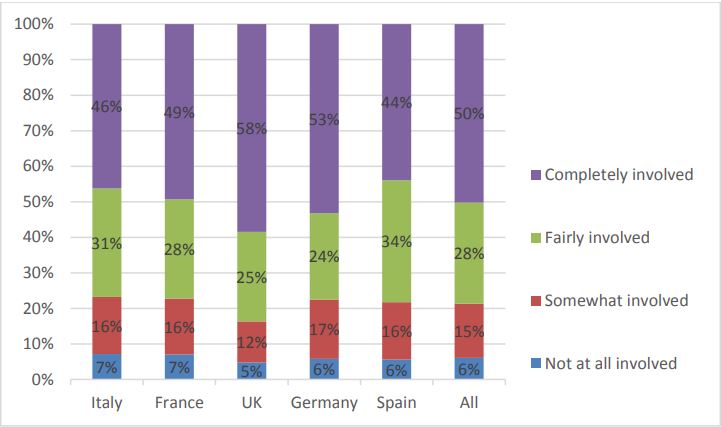 Figure 4: Level of involvement in your household when preparing and cooking fish.
Figure 4: Level of involvement in your household when preparing and cooking fish.
Table 6 shows the fish choice motives expressed by the participants. Value for money, price and general appearance are the most important attributes in every country. However, in Italy wild caught and days since catch/harvest (likely as a proxi of freshness) are more important than price. Easy to cook is ranked as another important attribute in fish selection, in particular in France, UK and Germany. Sustainability certification is ranked as 5th and 6th aspect in fish selection, respectively, in Germany and Spain. Table 7 shows the level of agreement on the attitudinal beliefs attitude towards environmental concerns (AE), attitude towards health concerns (AH), self-efficacy (SE), trust in information about sustainable production (TI), attitude towards ready-to-cook fish (AR). The results about the attitudinal beliefs are also displayed in Figures 5-9.
Table 6: Relative importance of different aspects in fish selection (1 = Not at all important; 7 = Extremely important).
| France | Germany | Italy | Spain | UK | Total | |||||||
|---|---|---|---|---|---|---|---|---|---|---|---|---|
| Fish choice motives | Mean | sd | Mean | sd | Mean | sd | Mean | sd | Mean | sd | Mean | sd |
| Value for money | 5.63 | 1.24 | 5.15 | 1.39 | 5.61 | 1.17 | 5.62 | 1.27 | 5.33 | 1.42 | 5.47 | 1.31 |
| Price | 5.57 | 1.24 | 5.10 | 1.34 | 5.31 | 1.25 | 5.44 | 1.29 | 5.29 | 1.42 | 5.34 | 1.32 |
| General appearance | 5.43 | 1.49 | 5.19 | 1.48 | 5.66 | 1.38 | 5.38 | 1.47 | 5.01 | 1.65 | 5.33 | 1.51 |
| Free of smell | 4.81 | 1.64 | 4.77 | 1.64 | 5.17 | 1.48 | 5.34 | 1.49 | 4.90 | 1.76 | 5.00 | 1.62 |
| Easy to cook | 5.09 | 1.44 | 4.87 | 1.49 | 4.99 | 1.35 | 4.97 | 1.44 | 5.00 | 1.49 | 4.98 | 1.44 |
| Days since catch/harvest | 5.01 | 1.51 | 4.39 | 1.63 | 5.36 | 1.43 | 5.25 | 1.46 | 4.70 | 1.67 | 4.94 | 1.58 |
| Sustainability certification | 4.80 | 1.48 | 4.81 | 1.59 | 5.14 | 1.36 | 5.09 | 1.45 | 4.65 | 1.72 | 4.90 | 1.54 |
| Domestic origin | 5.01 | 1.47 | 4.13 | 1.57 | 5.26 | 1.42 | 4.97 | 1.49 | 4.35 | 1.68 | 4.74 | 1.59 |
| Wild caught | 4.77 | 1.44 | 4.01 | 1.47 | 5.39 | 1.34 | 4.74 | 1.49 | 4.33 | 1.64 | 4.65 | 1.55 |
| Organic certification | 4.60 | 1.45 | 4.04 | 1.69 | 4.94 | 1.45 | 5.00 | 1.47 | 3.92 | 1.77 | 4.50 | 1.64 |
| Not previously frozen | 4.54 | 1.61 | 3.88 | 1.55 | 5.11 | 1.54 | 4.81 | 1.58 | 4.16 | 1.70 | 4.50 | 1.66 |
| Low in calories | 4.28 | 1.61 | 3.89 | 1.65 | 4.45 | 1.61 | 4.62 | 1.50 | 4.16 | 1.77 | 4.28 | 1.65 |
Table 7: Level of agreement on the following attitudinal beliefs: attitude towards environmental concerns (AE), attitude towards health concerns (AH), self-efficacy (SE), trust in information about sustainable production (TI), attitude towards ready-to-cook fish (AR).
| France | Germany | Italy | Spain | UK | Total | ||||||||
|---|---|---|---|---|---|---|---|---|---|---|---|---|---|
| Fish choice motives | Att | Mean | sd | Mean | sd | Mean | sd | Mean | sd | Mean | sd | Mean | sd |
| I believe that fishing has negative consequences on marine resources. | AE | 4.73 | 1.43 | 4.39 | 1.41 | 4.02 | 1.53 | 4.39 | 1.52 | 4.27 | 1.41 | 4.36 | 1.48 |
| I believe that fish farming has negative consequences on the environment. | AE | 4.38 | 1.47 | 3.79 | 1.44 | 3.74 | 1.51 | 3.88 | 1.66 | 4.14 | 1.44 | 3.98 | 1.52 |
| I believe that eating fish containing omega-3 fatty acids benefits my health. | AH | 5.40 | 1.34 | 5.41 | 1.22 | 5.57 | 1.27 | 5.69 | 1.35 | 5.42 | 1.30 | 5.50 | 1.30 |
| I believe that eating fish would expose myself to substances (e.g. mercury, antibiotics, etc.) risking negative consequences on my health. | AH | 3.99 | 1.53 | 3.79 | 1.42 | 3.95 | 1.50 | 4.19 | 1.61 | 3.64 | 1.56 | 3.91 | 1.54 |
| I feel confident in evaluating the quality of the fish before buying it. | SE | 4.85 | 1.25 | 4.47 | 1.25 | 4.85 | 1.23 | 5.06 | 1.38 | 4.76 | 1.39 | 4.80 | 1.32 |
| I feel confident in cooking fish. | SE | 4.97 | 1.28 | 4.88 | 1.33 | 5.11 | 1.29 | 5.38 | 1.32 | 5.14 | 1.48 | 5.09 | 1.35 |
| I would trust the information provided about the sustainable fish production practices (fishing or farming) if they were certified by a public authority (e.g., the Government or the EU) | TI | 4.49 | 1.43 | 4.68 | 1.39 | 4.79 | 1.47 | 5.00 | 1.54 | 4.88 | 1.46 | 4.77 | 1.47 |
| I would trust the information provided about the sustainable fish production practices (fishing or farming) if they were certified by a fish farmer or fisherman | TI | 4.71 | 1.38 | 4.53 | 1.35 | 4.65 | 1.37 | 4.85 | 1.36 | 4.69 | 1.39 | 4.68 | 1.37 |
| I would trust the information provided about the sustainable fish production practices (fishing or farming) if they were certified by a fish processing industry | TI | 3.97 | 1.51 | 3.91 | 1.44 | 4.43 | 1.41 | 4.65 | 1.47 | 4.47 | 1.45 | 4.29 | 1.49 |
| I would trust the information provided about the sustainable fish production practices (fishing or farming) if they were certified by a retailer | TI | 4.19 | 1.39 | 4.16 | 1.36 | 4.30 | 1.42 | 4.47 | 1.47 | 4.48 | 1.33 | 4.32 | 1.40 |
| I would trust the information provided about the sustainable fish production practices (fishing or farming) if they were certified by an independent organization (e.g., an NGO) | TI | 4.89 | 1.34 | 4.81 | 1.34 | 4.91 | 1.41 | 4.96 | 1.52 | 4.93 | 1.38 | 4.90 | 1.40 |
| I believe that ready-to-cook products would alter the original fish characteristics | AR | 4.91 | 1.32 | 4.45 | 1.15 | 4.47 | 1.25 | 4.95 | 1.39 | 4.52 | 1.21 | 4.66 | 1.28 |
| I prefer to eat ready-to-cook fish because it allows me to save time | AR | 3.89 | 1.66 | 4.49 | 1.34 | 4.03 | 1.46 | 4.03 | 1.65 | 4.34 | 1.58 | 4.15 | 1.56 |
| Preferably, I spend as little time as possible on meal preparation | AR | 3.74 | 1.64 | 4.35 | 1.45 | 3.92 | 1.53 | 3.82 | 1.71 | 4.14 | 1.56 | 3.99 | 1.60 |
| I prefer to eat ready-to-cook fish because it does not smell | AR | 3.39 | 1.60 | 4.19 | 1.36 | 3.62 | 1.60 | 3.59 | 1.68 | 3.98 | 1.56 | 3.75 | 1.59 |
Note: all items are scored on the scale: 1 = Strongly disagree; 7 = Strongly agree.
In general consumers are more warried about the negative consequences of fishing on marine resources, than those of fish farming on the environment (Figure 5). The concern is higher in France and lower in Italy.
 Figure 5: Attitude towards environmental concerns.
Figure 5: Attitude towards environmental concerns.
In general, respondents believe that fish consumption has more benefits than risks (Figure 6). The benefits are more appreciated in Spain, as well as the risks of negative consequences.
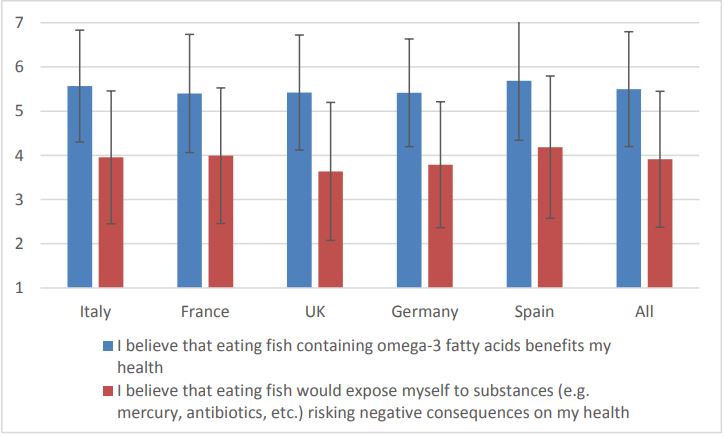 Figure 6: Attitude towards health concerns.
Figure 6: Attitude towards health concerns.
In general consumers are more confident in cooking fish than in evaluating the quality of the fish before buying it (Figure 7).
Consumers’ trust in information provided about the sustainable fish production is higher for independent organizations and public authorities, than for industries and retailers. Trust for farmers and fishermen is higher than trust for industry and retailers in every country. In France, the trust for fish farmers or fishermen is higher than for the public authority (Figure 8).
 Figure 8: Trust for information about sustainable fish production.
Figure 8: Trust for information about sustainable fish production.
In general, consumers show a rather negative perception about ready-to-cook products, in terms of loss of original characteristics. The preference for ready-to-cook fish products because of saving time is lower than the risk of alter the original fish characteristics (Figure 9). This difference is much larger in France and Spain, while is lower in the UK. Only in Germany consumers’ preference for ready-to-cook fish products is higher than the risk of alter the original fish characteristics.
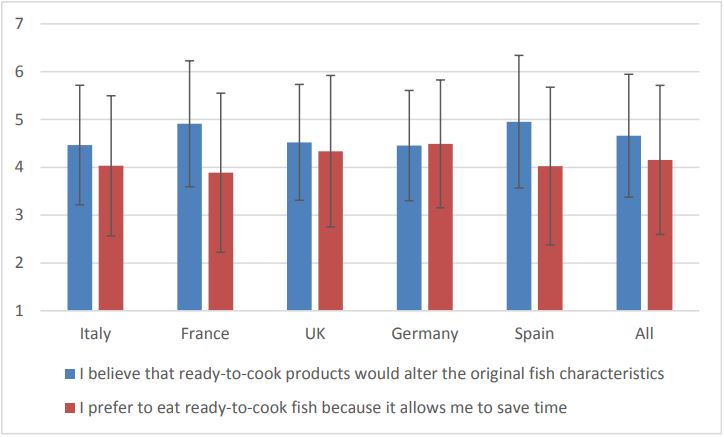 Figure 9: Attitude towards ready-to-cook fish.
Figure 9: Attitude towards ready-to-cook fish.
Once having performed the choice experiment, the respondents had to state how they believed in the benefits of sustainability certification to the environment and society, and how they believed in the nutrition and health claim. The results are reported in Figure 10 and 11. The belief strength is generally higher for the sustainability certification scheme, while, for both labels, is lower in France compared to Spain, Italy and UK.
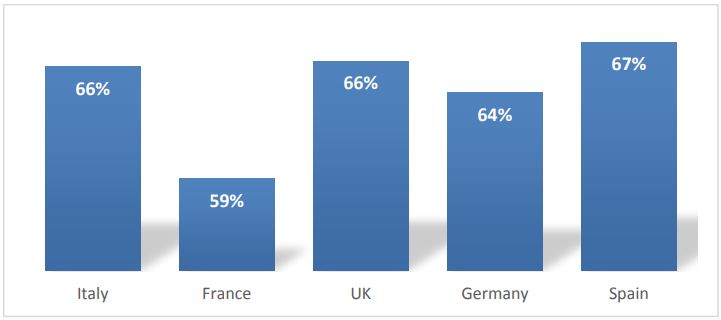 Figure 10: Belief strength about the sustainability label.
Figure 10: Belief strength about the sustainability label.
Note: “We assume you have read the definition of sustainability certification above. On a scale of 0-100, to what extent do you believe in the benefits of such certification to the environment and society? (e.g., 0 = completely unbelievable; 50 = neutral; 100 = completely believable)
 Figure 11: Belief strength about the nutritional and health claim.
Figure 11: Belief strength about the nutritional and health claim.
Note: “In the marketplace, some producers provide health benefit information from consuming their products. On a scale of 0-100, to what extent do you believe such health benefit claims? (e.g., 0 = completely unbelievable; 50 = neutral; 100 = completely believable).
3.2 The choice experiment results
Two different models were estimated:
- the first one with fish species-specific effects (FSSE); this is needed for obtaining WTP
specific for the 7 species;
- the second one with random price effect (RPE) models; this is needed for
segmentation.
3.2.1 Model specification and estimation
According to Lancaster’s consumer theory (1966), consumer utility stems from product attributes, not the products themselves. In other words, consumer utility can be separated into part-worth utilities. The part-worth utilities equal consumers’ preference for corresponding attributes. In marketing research, the product attributes are classified into extrinsic and intrinsic attributes (Zeithaml, 1988; Olsen et al., 2008). Regardless of whether consumers are exposed to these attributes, they may be important signals of product quality and determinants of consumer preference.
The overall utility that a consumer obtains from consuming a seafood species j (Uj) can be expressed as:
It is generally assumed that an individual would choose a product alternative if the utility derived from this alternative is maximized compared to the other alternatives:
When facing a “basket” of seafood products, consumers assign a random utility to each product alternatives and select the one with the highest derived utility. Assuming that the stochastic components εj have independent and identical distributed (iid) forms, the probability of a consumer i choosing a fish product j(P( yij = 1 ) given by the multinomial logit (MNL) model (McFadden, 1974), is expressed in the following equation:
The MNL model presented in equation (3) is the basic choice model and has been approved to have several disadvantages such as assuming iid of the error and assuming the homogeneity of consumers’ preference. To overcome the limitations of MNL, there many advanced discrete choice models suggested such as the mixed logit models (random coefficient, scaled-multinomial logit, and generalized-multinomial logit) and the latent class model (LCM) (see Fiebig et al., 2010; Greene & Hensher, 2003). We estimated two types of models in this report to elicit the consumers’ WTP for fish attributes that are specific to particular fish species and for individual consumers, named as fish speciesspecific effect model (FSSE) and random (i.e price) parameter effect model. The fish species-specific effect (FSSE) model (fish j), is expressed as:
where β parameters are estimated for the j-th fish species and for the attributes production method (i.e. Method, as wild caught vs. farmed fish), product format (i.e. Format, as whole fish/round cut, fillet or ready-to-cook), nutritional and health claim (i.e. Health, as with/without nutritional and health claim), and sustainability label (i.e. Sustain, as with/without sustainability certification). The Random price effect (RPE) model is specified so that the price coefficients includes two components, such as the average effect of price and the individual variance of price effects, expressed as:
where αj, βk are fixed-effect coefficients, γ3 is random coefficient of price estimated for individual i. The specification of FSSE allows us to calculate the willingness to pay (WTP) for each of seven fish species in the choice experiment, while random price effect model allows us to elicit the WTP of each fish attributes at individual consumers’ level. The WTP for a non-monetary attribute is the price premium that consumers are willing to pay for obtaining a desired attribute level. The WTP for an attribute level A (e.g. health) from FSSE model in equation (4) is calculated as:
where 𝑊𝑇𝑃Aj is the price premium paid for obtaining a desired level of attribute A (i.e., product with health claim) of the fish j, and β𝐴𝑗 and β5𝑗 are the estimated coefficients of attribute A and price attributes of fish j. Similarly, the WTP for attribute A (not specific to fish species) at consumers' individual level (𝑊𝑇𝑃𝐴i) is calculated from model in equation (5) is:
We estimate the WTP specific to fish species with expectation that consumers‘ preference for fish quality attributes depends in specific species (Thong et al., 2015). For instance, consumers may prefer filleted cod to the whole fish cod, but they may prefer whole fish herring to the filleted herring. The WTP for fish quality attributes are calculated at individual consumers because the nature of heterogeneity of preference. The random price effect model also allows us to obtain choice probability for fish species at the individual consumer‘s level. The individual consumers‘ choice probability thus will be used for segmentations that are actionable for marketing strategy and developing the decision support system (DSS). The segments are derived in every country using SAS macros, and three parameter criterion: cubic clustering criterion (Sarle, 1983), Pseudo-F statistics (Calinski and Harabasz, 1974), and Pseudo-t squared statistics (Duda and Hart, 1973).
Reports & Data
Data
Italy
Table 8 reports the coefficients estimates for models with fish species-specific effect (FSSE) in the Italian sample. The higher coefficient reported for seabass indicate that this species is the most preferred by the Italian consumers, followed by cod and seabream, while the least preferred is herring. Wild caught alternative is the most preferred comparted to the farm-raised fish for all species, with higher incidence for cod and seabass. Ready-to-cook products are preferred compared to whole or round cut in the case of cod, herring and pangasius, while is less preferred for salmon and seabream. Fish fillet is preferred than ready-to-cook products for salmon, seabream and cod, while is less preferred for trout and seabass. The sustainability label is generally appreciated for all species, where the effect is higher for cod, seabream, pangasius and trout. The nutritional and health claim is also generally appreciated, where higher scores are found for seabream, pangasius and cod. The willingness to pay is directly derived from these results, applying the formula (6). The results are shown in Table 9, where the price premium (in €/kg) and the marginal WTP (in % above or below the average price in Table 3) are reported. Considering the production method, the higher relative WTP has been found in the case of wild salmon, compared to the farmraised alternative (+48%). Again the higher marginal WTP for format attribute is found for salmon fillet and round cut compared to the ready-to-cook alternative (respectively, +70% and +38%). The higher WTP for the sustainability scheme was found for cod (+27%), while the WTP for nutritional and health claim is higher for seabream (+27%).
Table 8: Fish Species-Specific Effect (FSSE) Model, β (mean and standard deviation) - Italy.
Table 9: Italian consumers' WTP a price premium (in €/kg and % above or below the average market price) for specific fish attributes, based on the estimates of the FSSE model.
The random price effect (RPE) model, able to estimate the price coefficient for every single consumer, resulted in the mean effects (and standard deviation) reported in Table 10. The attribute effects, in this case, are computed without the interaction with the species (i.e. on average for all species). The higher utility score was found for wild caught fishes compared to the farm-raised ones, and for the sustainability label and nutritional and health claims. The WTP estimates, based on these effects, are reported in Table 11. These estimates are the mean values estimated for each consumer in the sample.
Table 10: Random Price Effect (RPE) model, β (mean and standard deviation) - Italy.
Table 11: Italian consumers' WTP (in €/kg) for fish species and attributes, based on the estimates of the RPE model.
The choice probability for fish species is reported in Table 12. This probability is very similar using both models, indicating the robustness of the effects across the models. Seabream, seabass and salmon exhibit the higher choice probability, while herring and pangasius and trout the lowest.
Table 12: Choice probability for fish species (mean value, standard deviation, minimum and maximum) with Fish Species-Specific Effect (FSSE) and Random Price Effect (RPE) models - Italy.
We have derived five different segments, based on choice probabilities, shown in Table 13. The first cluster is the largest (36% of the sample), and exhibits a higher WTP in general for all fish species and attributes. It is indeed one of the least sensitive to price changes. Mostly composed by females, middle aged, high educated and with high income level, living in a medium-large family. The second segment (12% of the sample) exhibits a low WTP, compared to the other segments, and a high sensitivity to price changes. It is made of females (61%), with lower education level, mostly living in two people families. The third segment is the second large one (30%), and expressed a medium WTP for all species, and a medium-high WTP for sustainability label and wild-caught fishes. It shows a low sensitivity with price changes. It is mostly composed by men (53%), middle-high aged, both low and high educated, with medium income and large family units (> three people). The fourth segment, representing 20% of the sample, shows slightly higher WTP values compared to the third one, only with a higher sensitivity with price changes. It is mostly composed by men (58%), younger, with lower educational level, and lower income (even if the higher income level is well represented), and living in larger family units. The fifth sample is the smallest (3%), and exhibits a low WTP for all species and attributes, and high price sensitivity.
Table 13: Segmentation of the Italian market, based on individuals’ choice probabilities.
France
Table 14 reports the coefficients estimates in the French sample for models with fish speciesspecific effect (FSSE). The higher β coefficient reported for seabream, cod and seabass indicate that these species are the most preferred by the French consumers, while the least preferred are herring and pangasius. Wild caught alternative is preferred comparted to the farm-raised fish for all species, with higher incidence for seabream. Ready-to-cook products are preferred compared to whole or round cut for all species, except with salmon. Fish fillet is preferred than ready-tocook products for salmon and cod, while is less preferred for pangasius. The sustainability label is generally appreciated by consumers, with higher effects for seabass and pangasius. The nutritional and health claim is appreciated for seabass, whilst the other effects are less significant. The willingness to pay results, applying the formula (8), are shown in Table 15 where the price premium (in €/kg) and the marginal WTP (in % above or below the average price in Table 3) are reported. Considering the production method, the higher relative WTP has been found in the case of wild salmon, compared to the farm-raised alternative (+58% compared to average market price); high premiums have been also estimated for wild seabream (+34%) and wild cod (+33%). The higher marginal WTP for format attribute is found for salmon fillet and round cut compared to the ready-to-cook alternative (respectively, +58% and +48%). Round cut pangasius is the least accepted, with a WTP for ready-to-cook alternative of 72%. Significant price premiums are also estimated for ready-to-cook cod (35%) and herring (33%), compared to, respectively, round cut and whole alternatives. The higher price premium for the sustainability scheme was found for salmon (+23%), seabass (+20%) and pangasius (+17%); the WTP for nutritional and health claim is higher for seabass (+13%).
Table 14: Fish Species-Specific Effect (FSSE) Model, β (mean and std. deviation) - France.
Table 15: French consumers' WTP a price premium (in €/kg and % above or below the average market price) for specific fish attributes, based on the estimates of the FSSE model.
The random price effects (RPE) model results (mean and standard deviation) are reported in Table 16 where the β coefficients are shown. The higher utility score was found for salmon and cod, and for wild caught fishes compared to the farm-raised ones. To a lesser extent the β coefficients are also positive for the fillets compared to the ready-to-cook alternatives, and for the sustainability label. The WTP estimates, based on these effects, are reported in Table 17; the higher premiums are associated with salmon and cod (respectively, 24.6 and 20.6 €/kg), and with wild-caught fishes (3.2 €/kg). The relatively low willingness to pay of French consumers for both sustainability label and nutritional and health claim can be partially explained by their weak belief strength in the benefits of sustainability certification to the environment and society, and in the nutrition and health claim.
Table 16: Random Price Effect (RPE) model, β (mean and standard deviation) - France.
Table 17: French consumers' WTP (in €/kg) for fish species and attributes, based on the estimates of the RPE model.
The choice probability for fish species is reported in Table 18. This probability is very similar using both models, indicating the robustness of the effects across the models. Salmon, cod and seabream exhibit the higher choice probability, while pangasius and herring the lowest.
Table 18: Choice probability for fish species (mean value, standard deviation, minimum and maximum) with Fish Species-Specific Effect (FSSE) and Random Price Effect (RPE) models - France.
Finally, we have derived six different segments, based on choice probabilities, shown in Table 19. The first two segments (CL1 and CL2), representing overall 45% of the sample, have the largest WTP scores for all fish species and attributes, including a higher WTP for ready-tocook fishes compared to whole alternatives. These two clusters are less sensitive to price changes. The first segment is mostly composed by younger males, highly educated and with higher income level, living in two-three people families. The second segment is mostly composed by older females, highly educated and with higher income level, living in largersized families (four people). The third segment (29% of the sample) exhibits an average WTP, compared to the other segments. It is mostly made of males (53%), middle-high aged, less educated and with lower income, mostly living alone. The fourth and the fifth segments, representing 9% and 5% of the sample, show low price premiums compared to the other ones, exhibiting a higher sensitivity with price changes. Segment four is mostly composed by young females (64%), with lower education and income, living either alone or in larger families (four people or more). Segment six, representing 13% of the sample, exhibits a medium-low willingness to pay premium for all species, but with low sensitivity with price change. It is mostly composed by young males with medium educational level, and high income, living in larger family units (three and more components).
Table 19: Segmentation of the French market, based on individuals’ choice probabilities.
Germany
Table 20 reports the coefficients estimates in the German sample for models with fish speciesspecific effect (FSSE), with and without beliefs. Cod, salmon, trout and seabass reported the higher β coefficients, indicating that these species are the most preferred by German consumers. Wild caught alternative is the most preferred comparted to the farm-raised fish for all species, with higher β coefficient for seabass. Readyto-cook products are generally preferred compared to whole (or round cut) fishes and fillets, except for salmon, where fillet is preferred than ready-to-cook product. The sustainability label is generally appreciated for all species, with more significant effects where found for seabass and seabream. The nutritional and health claim reported higher coefficients for seabream and herring. The willingness to pay results, applying the formula (8), are shown in Table 21. Wild-caught seabass exhibits the highest premium compared to the farm-raised alternative (+51% above the average market price), followed by wild-caught salmon (+35%) and seabream (+32%). As said before, the ready-to-cook products are generally preferred, with highest premiums found for pangasius, cod and seabass, compared to the whole or round cut fish. Consumers are willing to pay 38% price premium for salmon fillets compared to ready-to-cook products. The higher marginal WTP for the sustainability label was found for seabream (+53%), pangasius (49%) and seabass (42%). The WTP for nutritional and health claim is higher for pangasius (+44%) and seabream (+30%).
Table 20: Fish Species-Specific Effect (FSSE) Model, β (mean and std. deviation) - Germany.
Table 21: German consumers' WTP a price premium (in €/kg and % above or below the
average market price) for specific fish attributes, based on the estimates of the FSSE model.
The RPE model effects (β coefficients mean and standard deviation) are reported in Table 22. The higher utility score was found for salmon, trout and cod, and for wild-caught fishes compared to the farm-raised ones and for ready-to-cook products compared to whole or round cut fishes. The β coefficients are also significant for the sustainability label and nutritional and health claim. The WTP estimates, based on these effects, are reported in Table 23; the higher premiums are associated with salmon and trout (respectively, 28.5 and 22.6 €/kg), and with ready-to-cook (2.7 €/kg compared to the whole alternative) and wild-caught fishes (2.4 €/kg).
Table 22: Random Price Effect (RPE) model, β (mean and standard deviation) - Germany.
Table 23: German consumers' WTP (in €/kg) for fish species and attributes, based on the estimates of the RPE model.
Table 24 shows the choice probability for fish species. This probability is higher for salmon, trout and pangasius, while is lower for seabream and seabass.
Table 24: Choice probability for fish species (mean value, standard deviation, minimum and maximum) with Fish Species-Specific Effect (FSSE) and Random Price Effect (RPE) models - Germany.
We have derived four different segments, based on choice probabilities, shown in Table 25. The first cluster, representing 28% of the sample, is the one with the highest willingness to pay for all species and attributes, including the ready-to-cook alternatives. It is almost equally composed by young males and females, with medium-to-high educational level, and high incomes, mostly living with small family units (one or two members). Segment two is the smallest one (13.5%). It reports a low willingness to pay for all species and attributes, compared to the other segments. This segment is made by young and old people (middle aged less represented), with medium educational level, and high income, living in large family units (three people or more). The third segment is the largest (32%); it exhibits a medium willingness to pay for species and attributes. It is mostly composed by males, middle-old aged, average education, high income, and living in families with two people. Finally, the fourth segment (26%), reports a low willingness to pay for all species and attributes. It is made by middle-age females (59%), with low educational level, middle income and living in small family units.
Table 25: Segmentation of the German market, based on individuals’ choice probabilities.
UK
Table 26 reports the coefficients estimates in the UK sample for models with fish speciesspecific effect (FSSE). The high coefficients reported for salmon and cod indicate that these species are the most preferred by the UK consumers, while the least preferred are pangasius and seabass, exhibiting a negative β coefficient which denotes that these species decrease the consumers’ utility. Wild caught alternative are generally preferred, in particular seabass and salmon. Ready-to-cook products are preferred compared to while or round cut for all fish species, except for salmon. Fish fillet is preferred than ready-to-cook products for salmon and seabream, while it is less preferred for trout and pangasius. The sustainability label is mostly appreciated for herring and seabream, whilst it is detrimental for consumers’ utility in the case of pangasius. The nutritional and health claim is mostly appreciated for pangasius, salmon and trout. Table 10 shows the WTP estimates, in £/kg and as a % of the average price, applying the formula (8). The results show a +48% price premium consumers are willing to pay for wildcaught seabass compared to farmed alternative. The higher marginal WTP for format attribute have been found for ready-to-cook products, compared to whole/round cut fish, in the case of herring (81%), seabass (49%), cod (37%), trout (33%) and seabream (30%). Salmon fillet is preferred compared to the ready-to-cook alternative (+44%). The higher WTP for the sustainability scheme was found for herring (+62%), while the WTP for nutritional and health claim is higher for pangasius (+26%).
Table 26: Fish Species-Specific Effect (FSSE) Model, β (mean and standard deviation) – UK.
Table 27: UK consumers' WTP a price premium (in £/kg, €/kg (5) and % of the average market price) for specific fish attributes, based on the estimates of the FSSE model.
(5) The exchange rate used is 1 GB £ = 1.16 €.
The RPE model results are reported in Table 28, where the β coefficients (mean and standard deviation) are shown.
Table 28: Random Price Effect (RPE) model, β (mean and standard deviation) - UK.
Table 29: UK consumers' WTP (in £/kg and €/kg (6) ) for fish species and attributes, based on the estimates of the RPE model.
6 The exchange rate used is 1 GB £ = 1.16 €.
The higher utility score was found for salmon and cod, and for wild caught fishes compared to the farm-raised ones. Ready-to-cook products are generally preferred compared to the whole/round cut alternatives. To a lesser extent the β coefficients are also positive for the fillets compared to the ready-to-cook alternatives, and for the sustainability label. The WTP estimates, based on these effects, are reported in Table 29; the higher premiums for fish species are associated with salmon and cod (respectively, 23.4 and 21.8 €/kg). For the attributes, wild-caught fishes carry the higher premiums (1.8 €/kg), followed by ready-to-cook products compared to whole alternative (1.4 €/kg), and by fish fillets compared to ready-tocook ones (1.1 €/kg). The choice probability, reported in Table 30, indicate that salmon and cod are the most chosen alternatives, while pangasius, seabream and trout are the least preferred ones.
Table 30: Choice probability for fish species (mean value, standard deviation, minimum and maximum) with Fish Species-Specific Effect (FSSE) and Random Price Effect (RPE) models - UK.
We have derived four different segments for the UK market, based on choice probabilities (Table 31). The first segment (13%) is the one with the lowest WTP for all species and attributes, and the one more sensitive with price changes. It shows, compared to the other segments, a higher incidence of middle-aged females, with low education and low income, living in larger family units. Segment 2 is the largest one (41% of the sample), showing, compared to the other segment a medium-high WTP. Younger males are more represented, with higher educational level and income, and living in families with three or four members. The third segment (27%) shows low estimates of premium prices; it is mostly composed by females, with medium income level and education, living in small family units. Segment 4 (19%) is the one with the highest estimated WTP; middle-aged and older females are more represented, as well as middle educated and income levels, and mostly living in families with two members.
Table 31: Segmentation of the UK market, based on individuals’ choice probabilities.
Spain
Table 32 reports the coefficients estimates in the Spanish sample for models with fish speciesspecific effect (FSSE), with and without beliefs. Seabass, seabream and cod are the species with the highest β coefficients in the FSSE model, indicating a stronger preference of Spanish consumers for these products, while pangasius is the least preferred one. Wild-caught alternative are generally appreciated, while wild-caught seabass carrying the highest utility. Ready-to-cook products are preferred compared to while or round cut in the case of cod, pangasius and herring, while it is less preferred for salmon and seabream. This result is very similar to the Italian case. Fish fillets are generally preferred than ready-to-cook products apart from trout and pangasius. The sustainability label coefficient carrying the higher utility for consumers was found for trout, herring and seabream. The nutritional and health claim is generally appreciated, where higher scores are found for pangasius. The price premiums (in €/kg and % of the average price) that Spanish consumers are willing to pay for species and attributes, estimated with formula (8), are shown in Table 33. The higher relative WTP has been found in the case of wild-caught seabass, compared to the farm-raised alternative (+19%). Salmon fillet carries the higher premium compared to ready-to-cook alternative (+53%), whilst ready-to-cook trout is preferred than the fillet alternative, showing a 47% WTP. Consumers are willing to pay a premium for ready-to-cook pangasius compared to round cut and fillets, respectively, +36% and 32% premium. The higher WTP for the sustainability label and nutritional and health claim was found for trout (respectively, +33% and +37%) and pangasius (respectively, +30% and +68%).
Table 32: Fish Species-Specific Effect (FSSE) Model, β (mean and standard deviation) - Spain.
Table 33: Spanish consumers' WTP a price premium (in €/kg and % above or below the average market price) for specific fish attributes, based on the estimates of the FSSE model.
The RPE model effects (β coefficients mean and standard deviation) are reported in Table 34. The higher utility score was found for salmon, seabream, seabass and cod, and for wild-caught fishes compared to the farm-raised ones. The β coefficients are also significant for the sustainability label and nutritional and health claim. The WTP estimates, based on these effects, are reported in Table 35; the higher premiums for species are associated with salmon (mean premium 20.7 €/kg), seabream (18.4 €/kg) and cod (18.1 €/kg). The nutritional and health claim carries the highest premium among the attributes, with 1.1 €/kg.
Table 34: Random Price Effect (RPE) model, β (mean and standard deviation) - Spain.
Table 35: Spanish consumers' WTP (in €/kg) for fish species and attributes, based on the estimates of the RPE model.
Table 36 shows the choice probability for fish species. This probability is higher for salmon, seabream and trout, while is lower for herring and pangasius.
Table 36: Choice probability for fish species (mean value, standard deviation, minimum and maximum) with Fish Species-Specific Effect (FSSE) and Random Price Effect (RPE) models - Spain.
We have derived seven different segments, based on choice probabilities, shown in Table 37. The first cluster, which is the larger one (21%), shows medium price premiums, compared to the other clusters, for species and attributes. It is mostly made by young females, highly educated, with high income and relatively medium-large family units (four people). Segment 2 (18% of the sample), showing the highest WTPs, is composed by young males, with high income, living in large family units (four people or more). Segment 3 shows medium-high WTP estimates too (19% of the sample), is relatively more representative of older females, with lower income level, living in smaller family units. The fourth segment (19% of the sample) shows an average WTP for species and attributes. It is mostly composed by middle-aged males, less educated and with lower income. Segments 5, 6 and 7 are all exhibiting lower premiums estimates for species and attributes.
Table 37: Segmentation of the Spanish market, based on individuals’ choice probabilities.
Appendix
Synthesis of the qualitative phase
Table A1: Familiarity, attributes, barriers, and format for fish species and countries, as retrieved from the qualitative phase (Task 4.1)
Preliminary list of attributes
Table A2: Preliminary list of attributes and levels by species.
Pictures of the format attribute
Table A3: Set of pictures of the format attribute, by species in each country.
France
Germany
Italy
Spain
UK
The questionnaire
Appendix A4: The questionnaire in the English version. (5 pages)
The tool
The WTP tool is a simple implementation of an aggregator value based on the data collected in the research phase. Similar to any other tool, the WTP can be accessed by clicking the quick access menu for the WTP in the [htpp://dss.primefish.eu/index.php/registered-home DSS] home page or by clicking its respective link in the top navigation bar. The user will be redirected to the WTP home page.
WTP home page
Once in the home page, the user can select the different attributes of the proposed product to be analysed and click the Run WTP tool button to generate the results.
WTP results page
The results page displays to the user the maximum valuer that a consumer is willing to pay for a product. It also shows the WTP ammount variation for each attribute in the chosen country, as well as the WTP comparison for the same attributes chosen but for different species in the country selected. The user can click the button on the bottom of the results page to return to the WTP home page and perform another analysis or click any other link to navigate to other sections of the DSS.
References & Readings
Conclusions
The activity performed in Task 4.4, resulting in this Deliverable (D4.7), investigated consumer demand and choice behaviour for fresh fish using an online choice experiment. In particular, we examined consumer preferences in five countries for different fish alternative species and attributes, using a labelled choice experiment (LCE). The results in terms of part-worth associated with the single attributes allowed to estimate consumers’ willingness to pay (WTP) for the salient product characteristics. The heterogeneous choices and preferences across countries and species suggested the application of a model where the attribute part-worth were estimated separately for every species in every country (fish species-specific effects model – FSSE). Using a random price effect (RPE) model we estimated the effects and WTP for attributes at consumers’ individual level; the individual consumers‘ choice probability so estimated thus was used for segmentations in every country. These results are actionable for marketing strategy and useful input in the developing of the decision support system (PrimeDSS). In particular, using the WTP results of the FSSE model it will be possible to estimate, in the five countries, the consumers’ willingness to pay a premium for specific species-related attributes cumulated in a product profile with certain characteristics. In other words, the DSS user, by selecting the preferred characteristics of the given species in a specific country, will retrieve the estimated consumers’ willingness to pay for that product, based on the estimated model on the data collected. Given the representativeness of the sample in every country, this result will provide stakeholder with a clear guidance about the (hypothetical) consumers’ preferences for each product profile. Similarly, the segmentation performed using the RPE model will provide DSS users with more details about the characteristics of the market segment more attracted by the given product profile. In addition, RPE model effects will enable us to estimate price elasticities, in which cross price elasticities among fish species are not constant. With these outcome it will be possible to develop competitiveness clouds and vulnerability index. Finally, the present activity have been implemented in parallel with the survey in Task 5.4, with a number of common questions (the “bridge questions”) leaving the possibly to combine the results of both surveys in a more powerful tool to be implemented in the PrimeDSS. The results of WTP and price elasticity for markets and segments across the five surveyed countries, as well as the possibility to combine the survey in Tasks 4.4 and 5.4, will be further investigated in Tasks 5.4 and 5.5, and eventually used as an input for the PrimeDSS development in WP6 of the project.'
Acknowledgement
We gratefully acknowledge the Primefish project partners for having provided feedback and helpful input to the present research. In particular, we thank Birgit Hagen, Emilia Cubero Dudinskaya and Antonella Carcagnì (University of Pavia, Italy), José Luis Santiago CastroRial, (Centro Tecnológico del Mar - Fundación CETMAR, Spain), Dimitar Taskov (University of Stirling, United Kingdom), Sterenn Lucas (Institut National de la Recherche Agronomique – INRA, France), Bjorn Suckow (TTZ, Germany), and Olga Untilov (Universite de Savoie, France).
References
Calinski, T. & Harabasz, J. (1974). A Dendrite Method for Cluster Analysis. Communications in Statistics, 3, 1–27.
Carlucci D., Nocella G., De Devitiis B., Viscecchia R., Bimbo F., Nardone G. (2015). Consumer purchasing behaviour towards fish and seafood products. Patterns and insights from a sample of international studies. Appetite 84, 212–227.
Duda, R.O. & Hart, P.E. (1973). Pattern Classification and Scene Analysis, New York: John Wiley & Sons, Inc.
EEA (2016). Seafood in Europe: A food system approach for sustainability. European Environmental Agency Report No 25/2016.
EFSA (2009). Scientific Opinion on the substantiation of health claims related to EPA, DHA, DPA and maintenance of normal blood pressure (ID 502), maintenance of normal HDLcholesterol concentrations (ID 515), maintenance of normal (fasting) blood concentrations of triglycerides (ID 517), maintenance of normal LDL-cholesterol concentrations (ID 528, 698) and maintenance of joints (ID 503, 505, 507, 511, 518, 524, 526, 535, 537) pursuant to Article 13(1) of Regulation (EC) No 1924/2006. EFSA Panel on Dietetic Products, Nutrition and Allergies (NDA), Parma (Italy).
EFSA (2010). Scientific Opinion on the substantiation of health claims related to eicosapentaenoic acid (EPA), docosahexaenoic acid (DHA), docosapentaenoic acid (DPA) and maintenance of normal cardiac function (ID 504, 506, 516, 527, 538, 703, 1128, 1317, 1324, 1325), maintenance of normal blood glucose concentrations (ID 566), maintenance of normal blood pressure (ID 506, 516, 703, 1317, 1324), maintenance of normal blood HDL-cholesterol concentrations (ID 506), maintenance of normal (fasting) blood concentrations of triglycerides (ID 506, 527, 538, 1317, 1324, 1325), maintenance of normal blood LDL-cholesterol concentrations (ID 527, 538, 1317, 1325, 4689), protection of the skin from photo-oxidative (UV-induced) damage (ID 530), improved absorption of EPA and DHA (ID 522, 523), contribution to the normal function of the immune system by decreasing the levels of eicosanoids, arachidonic acid-derived mediators and pro-inflammatory cytokines (ID 520, 2914), and “immunomodulating agent” (4690) pursuant to Article 13(1) of Regulation (EC) No 1924/2006. EFSA Panel on Dietetic Products, Nutrition and Allergies (NDA), Parma (Italy).
EUMOFA (2015). The EU fish market — 2015 edition, European Market Observatory for Fisheries and Aquaculture Products. FAO (2016). The state of world fisheries and aquaculture. Contributing to food security and nutrition for all, Food and Agriculture Organization of the United Nations, Rome. Fiebig, D.G., Keane, M.P., Louviere, J.J, & Wasi, N. (2010). The generalized multinomial logit model: accounting for scale and coefficient heterogeneity. Marketing Science, 29(3), 393-421.
Greene, W.H., & Hensher, D.A. (2003). A latent class model for discrete choice analysis: contrasts with mixed logit. Transportation Research B, 37(8), 681-698.
Lancaster, K. J. (1966). A new approach to consumer theory. The Journal of Political Economy, 132–157.
Lancaster, K.J. (1966). A New Approach to Consumer Theory. Journal of Political Economics 74(2):132-57.
Louviere, J. J., Hensher, D. A., & Swait, J. D. (2000). Stated choice methods: Analysis and application. Cambridge UK: Cambridge University Press.
Mauracher C., Tempesta T., Vecchiato D. (2013). Consumer preferences regarding the introduction of new organic products. The case of the Mediterranean sea bass (Dicentrarchus labrax) in Italy. Appetite 63, 84–91.
McClenachan L., Dissanayake S.T.M., Chen X. (2016). Fair trade fish: consumer support for broader seafood sustainability. Fish and Fisheries 17, 825–838.
McFadden, D. (1974). Conditional Logit Analysis of Qualitative Choice Behavior. In P.
Zarembka (ed.), Frontiers in Economics. New York: Academic Press.
Nguyen T.T., Haider W., Stubbe Solgaard H., Ravn-Jonsen L., Roth E. (2015). Consumer willingness to pay for quality attributes of fresh seafood: A labeled latent class model. Food Quality and Preference 41, 225–236.
Olsen, S.O., K. Toften, D.C. Dopico, A. Tudoran, & A. Kole. (2008). Consumer Evaluation of Tailor-Made Seafood Products. Improving seafood products for the consumer. Børresen, T. Eds, CRC Press.
Sarle, W.S. (1983). Cubic Clustering Criterion, SAS Technical Report A-108, Cary, NC: SAS Institute Inc.
Stefani G., Scarpa R., Cavicchi A. (2012). Exploring consumer’s preferences for farmed sea bream. Aquaculture International 20(4), 673–691.
Zeithaml, V.A. (1988). Consumer Perceptions of Price, Quality, and Value: A Means-End Model and Synthesis of Evidence. Journal of Marketing 52(3): 2-22.

